Legal Writing and Research | Issues Study
VerifiedAdded on 2022/09/01
|19
|5279
|16
AI Summary
Contribute Materials
Your contribution can guide someone’s learning journey. Share your
documents today.
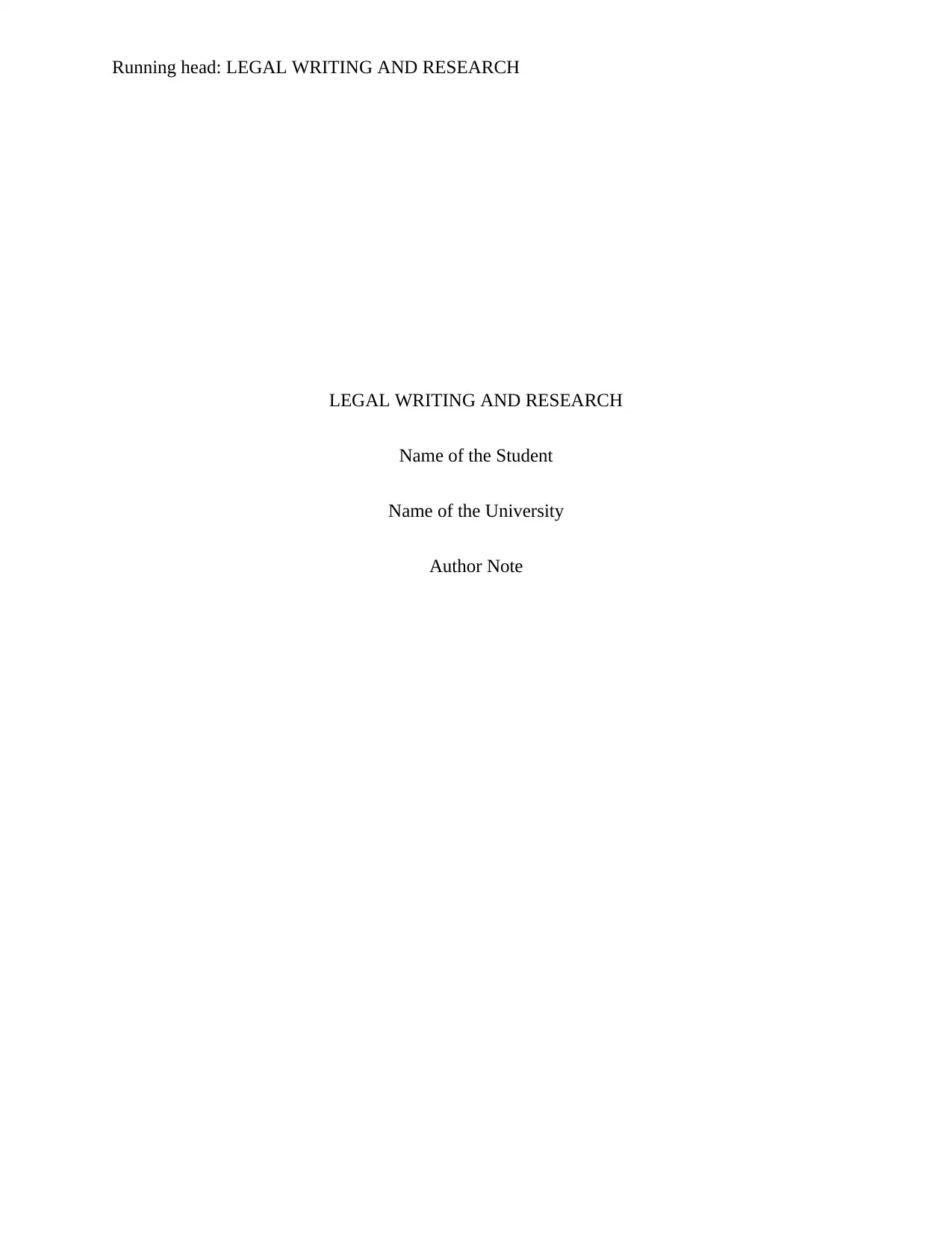
Running head: LEGAL WRITING AND RESEARCH
LEGAL WRITING AND RESEARCH
Name of the Student
Name of the University
Author Note
LEGAL WRITING AND RESEARCH
Name of the Student
Name of the University
Author Note
Secure Best Marks with AI Grader
Need help grading? Try our AI Grader for instant feedback on your assignments.
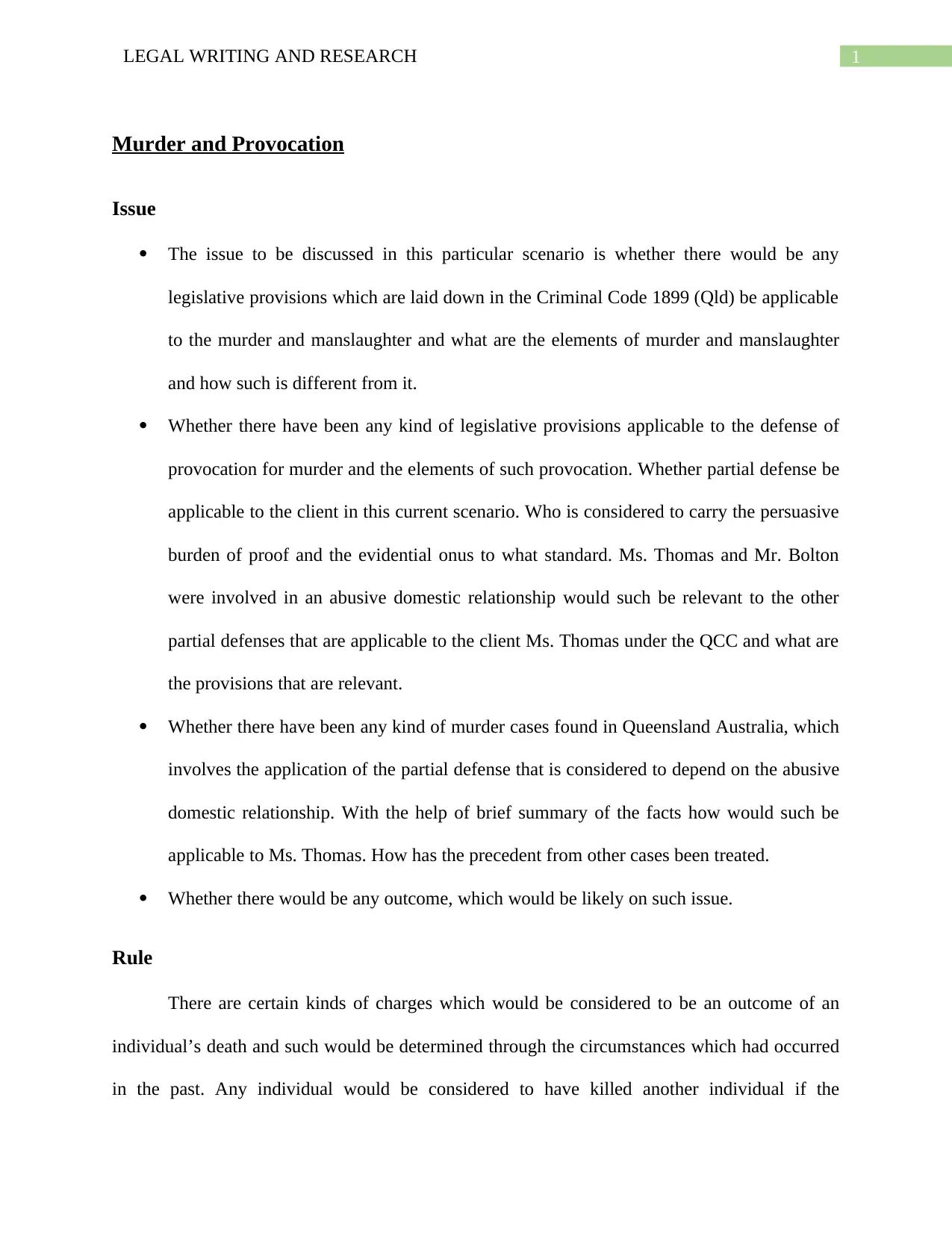
1LEGAL WRITING AND RESEARCH
Murder and Provocation
Issue
The issue to be discussed in this particular scenario is whether there would be any
legislative provisions which are laid down in the Criminal Code 1899 (Qld) be applicable
to the murder and manslaughter and what are the elements of murder and manslaughter
and how such is different from it.
Whether there have been any kind of legislative provisions applicable to the defense of
provocation for murder and the elements of such provocation. Whether partial defense be
applicable to the client in this current scenario. Who is considered to carry the persuasive
burden of proof and the evidential onus to what standard. Ms. Thomas and Mr. Bolton
were involved in an abusive domestic relationship would such be relevant to the other
partial defenses that are applicable to the client Ms. Thomas under the QCC and what are
the provisions that are relevant.
Whether there have been any kind of murder cases found in Queensland Australia, which
involves the application of the partial defense that is considered to depend on the abusive
domestic relationship. With the help of brief summary of the facts how would such be
applicable to Ms. Thomas. How has the precedent from other cases been treated.
Whether there would be any outcome, which would be likely on such issue.
Rule
There are certain kinds of charges which would be considered to be an outcome of an
individual’s death and such would be determined through the circumstances which had occurred
in the past. Any individual would be considered to have killed another individual if the
Murder and Provocation
Issue
The issue to be discussed in this particular scenario is whether there would be any
legislative provisions which are laid down in the Criminal Code 1899 (Qld) be applicable
to the murder and manslaughter and what are the elements of murder and manslaughter
and how such is different from it.
Whether there have been any kind of legislative provisions applicable to the defense of
provocation for murder and the elements of such provocation. Whether partial defense be
applicable to the client in this current scenario. Who is considered to carry the persuasive
burden of proof and the evidential onus to what standard. Ms. Thomas and Mr. Bolton
were involved in an abusive domestic relationship would such be relevant to the other
partial defenses that are applicable to the client Ms. Thomas under the QCC and what are
the provisions that are relevant.
Whether there have been any kind of murder cases found in Queensland Australia, which
involves the application of the partial defense that is considered to depend on the abusive
domestic relationship. With the help of brief summary of the facts how would such be
applicable to Ms. Thomas. How has the precedent from other cases been treated.
Whether there would be any outcome, which would be likely on such issue.
Rule
There are certain kinds of charges which would be considered to be an outcome of an
individual’s death and such would be determined through the circumstances which had occurred
in the past. Any individual would be considered to have killed another individual if the
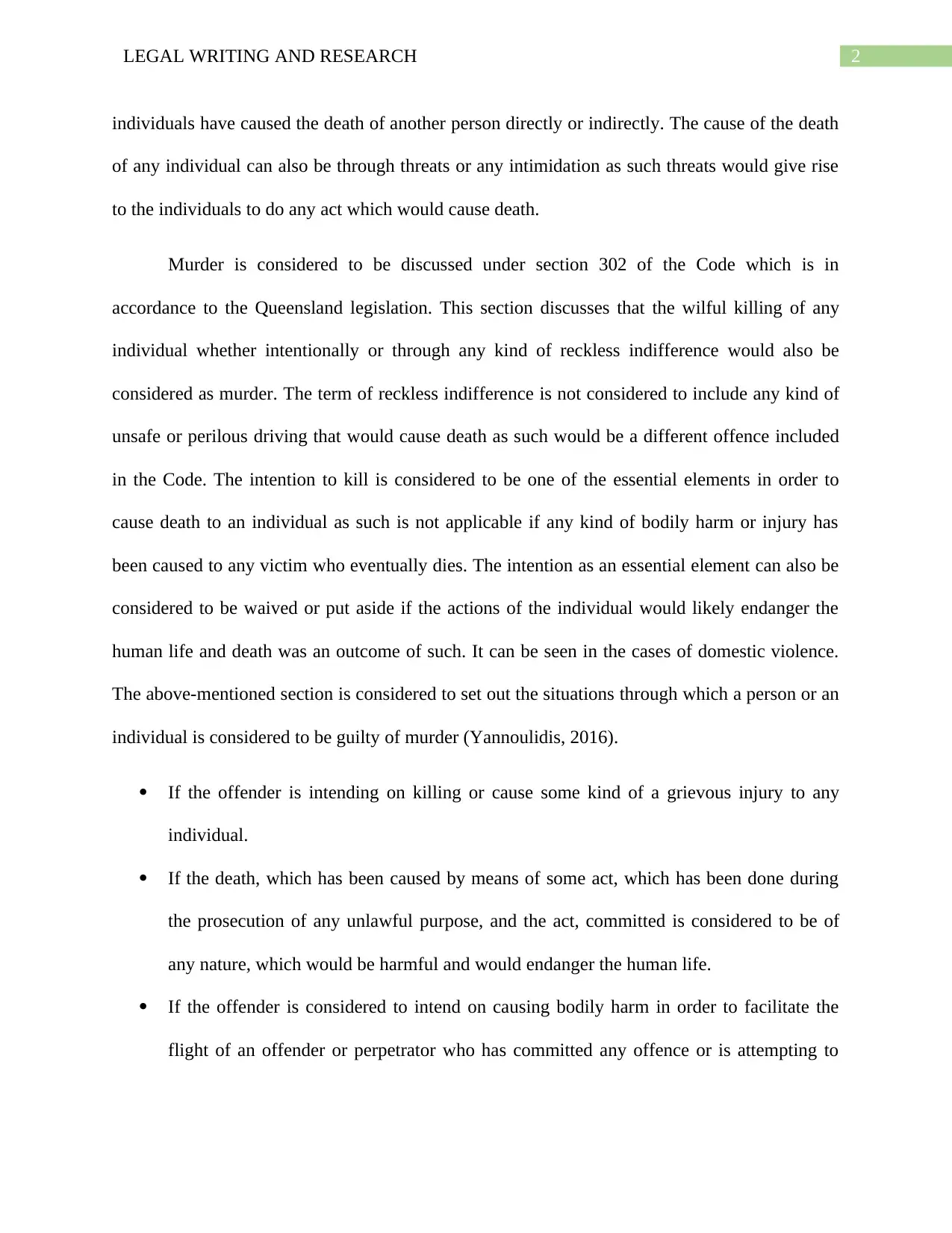
2LEGAL WRITING AND RESEARCH
individuals have caused the death of another person directly or indirectly. The cause of the death
of any individual can also be through threats or any intimidation as such threats would give rise
to the individuals to do any act which would cause death.
Murder is considered to be discussed under section 302 of the Code which is in
accordance to the Queensland legislation. This section discusses that the wilful killing of any
individual whether intentionally or through any kind of reckless indifference would also be
considered as murder. The term of reckless indifference is not considered to include any kind of
unsafe or perilous driving that would cause death as such would be a different offence included
in the Code. The intention to kill is considered to be one of the essential elements in order to
cause death to an individual as such is not applicable if any kind of bodily harm or injury has
been caused to any victim who eventually dies. The intention as an essential element can also be
considered to be waived or put aside if the actions of the individual would likely endanger the
human life and death was an outcome of such. It can be seen in the cases of domestic violence.
The above-mentioned section is considered to set out the situations through which a person or an
individual is considered to be guilty of murder (Yannoulidis, 2016).
If the offender is intending on killing or cause some kind of a grievous injury to any
individual.
If the death, which has been caused by means of some act, which has been done during
the prosecution of any unlawful purpose, and the act, committed is considered to be of
any nature, which would be harmful and would endanger the human life.
If the offender is considered to intend on causing bodily harm in order to facilitate the
flight of an offender or perpetrator who has committed any offence or is attempting to
individuals have caused the death of another person directly or indirectly. The cause of the death
of any individual can also be through threats or any intimidation as such threats would give rise
to the individuals to do any act which would cause death.
Murder is considered to be discussed under section 302 of the Code which is in
accordance to the Queensland legislation. This section discusses that the wilful killing of any
individual whether intentionally or through any kind of reckless indifference would also be
considered as murder. The term of reckless indifference is not considered to include any kind of
unsafe or perilous driving that would cause death as such would be a different offence included
in the Code. The intention to kill is considered to be one of the essential elements in order to
cause death to an individual as such is not applicable if any kind of bodily harm or injury has
been caused to any victim who eventually dies. The intention as an essential element can also be
considered to be waived or put aside if the actions of the individual would likely endanger the
human life and death was an outcome of such. It can be seen in the cases of domestic violence.
The above-mentioned section is considered to set out the situations through which a person or an
individual is considered to be guilty of murder (Yannoulidis, 2016).
If the offender is intending on killing or cause some kind of a grievous injury to any
individual.
If the death, which has been caused by means of some act, which has been done during
the prosecution of any unlawful purpose, and the act, committed is considered to be of
any nature, which would be harmful and would endanger the human life.
If the offender is considered to intend on causing bodily harm in order to facilitate the
flight of an offender or perpetrator who has committed any offence or is attempting to
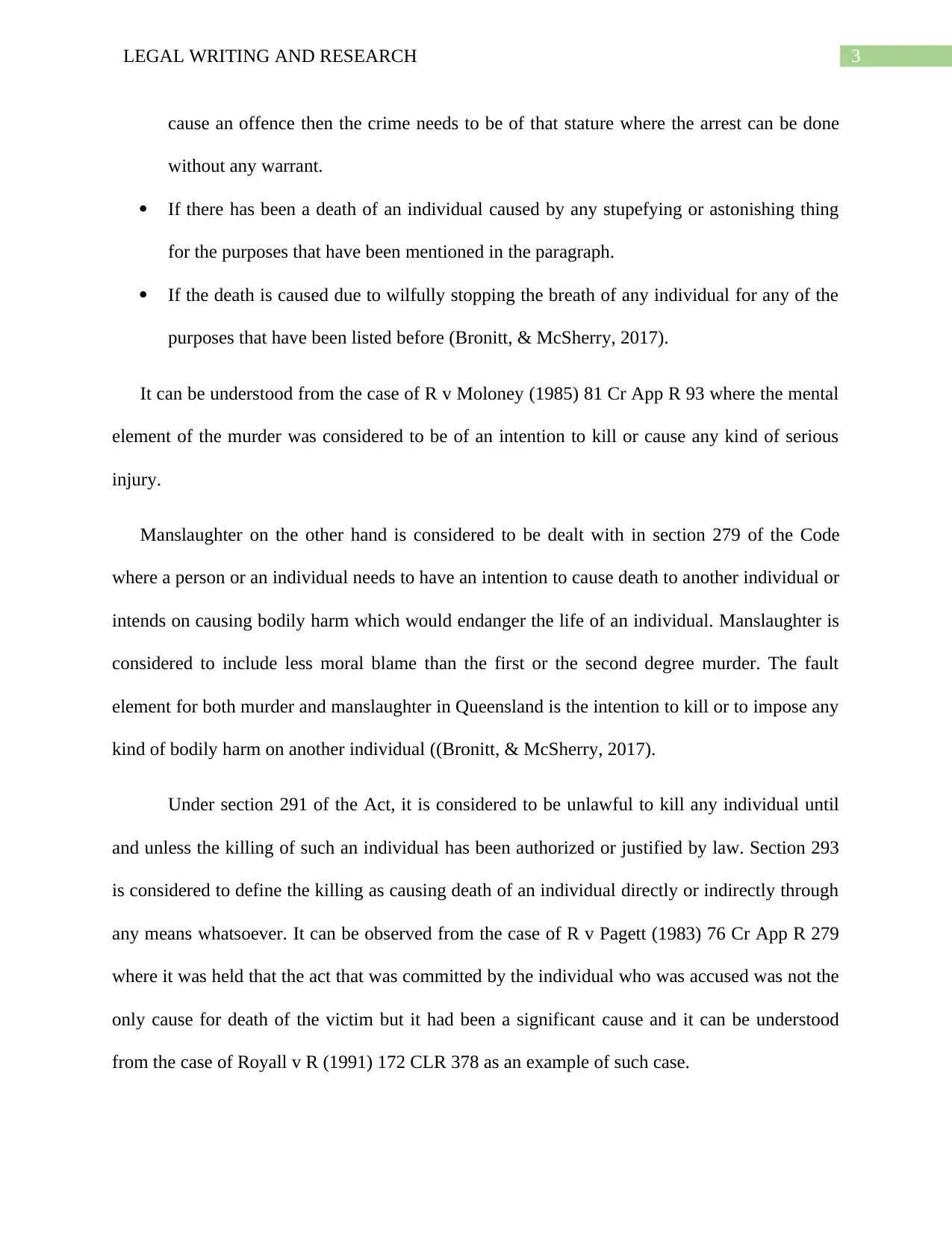
3LEGAL WRITING AND RESEARCH
cause an offence then the crime needs to be of that stature where the arrest can be done
without any warrant.
If there has been a death of an individual caused by any stupefying or astonishing thing
for the purposes that have been mentioned in the paragraph.
If the death is caused due to wilfully stopping the breath of any individual for any of the
purposes that have been listed before (Bronitt, & McSherry, 2017).
It can be understood from the case of R v Moloney (1985) 81 Cr App R 93 where the mental
element of the murder was considered to be of an intention to kill or cause any kind of serious
injury.
Manslaughter on the other hand is considered to be dealt with in section 279 of the Code
where a person or an individual needs to have an intention to cause death to another individual or
intends on causing bodily harm which would endanger the life of an individual. Manslaughter is
considered to include less moral blame than the first or the second degree murder. The fault
element for both murder and manslaughter in Queensland is the intention to kill or to impose any
kind of bodily harm on another individual ((Bronitt, & McSherry, 2017).
Under section 291 of the Act, it is considered to be unlawful to kill any individual until
and unless the killing of such an individual has been authorized or justified by law. Section 293
is considered to define the killing as causing death of an individual directly or indirectly through
any means whatsoever. It can be observed from the case of R v Pagett (1983) 76 Cr App R 279
where it was held that the act that was committed by the individual who was accused was not the
only cause for death of the victim but it had been a significant cause and it can be understood
from the case of Royall v R (1991) 172 CLR 378 as an example of such case.
cause an offence then the crime needs to be of that stature where the arrest can be done
without any warrant.
If there has been a death of an individual caused by any stupefying or astonishing thing
for the purposes that have been mentioned in the paragraph.
If the death is caused due to wilfully stopping the breath of any individual for any of the
purposes that have been listed before (Bronitt, & McSherry, 2017).
It can be understood from the case of R v Moloney (1985) 81 Cr App R 93 where the mental
element of the murder was considered to be of an intention to kill or cause any kind of serious
injury.
Manslaughter on the other hand is considered to be dealt with in section 279 of the Code
where a person or an individual needs to have an intention to cause death to another individual or
intends on causing bodily harm which would endanger the life of an individual. Manslaughter is
considered to include less moral blame than the first or the second degree murder. The fault
element for both murder and manslaughter in Queensland is the intention to kill or to impose any
kind of bodily harm on another individual ((Bronitt, & McSherry, 2017).
Under section 291 of the Act, it is considered to be unlawful to kill any individual until
and unless the killing of such an individual has been authorized or justified by law. Section 293
is considered to define the killing as causing death of an individual directly or indirectly through
any means whatsoever. It can be observed from the case of R v Pagett (1983) 76 Cr App R 279
where it was held that the act that was committed by the individual who was accused was not the
only cause for death of the victim but it had been a significant cause and it can be understood
from the case of Royall v R (1991) 172 CLR 378 as an example of such case.
Secure Best Marks with AI Grader
Need help grading? Try our AI Grader for instant feedback on your assignments.
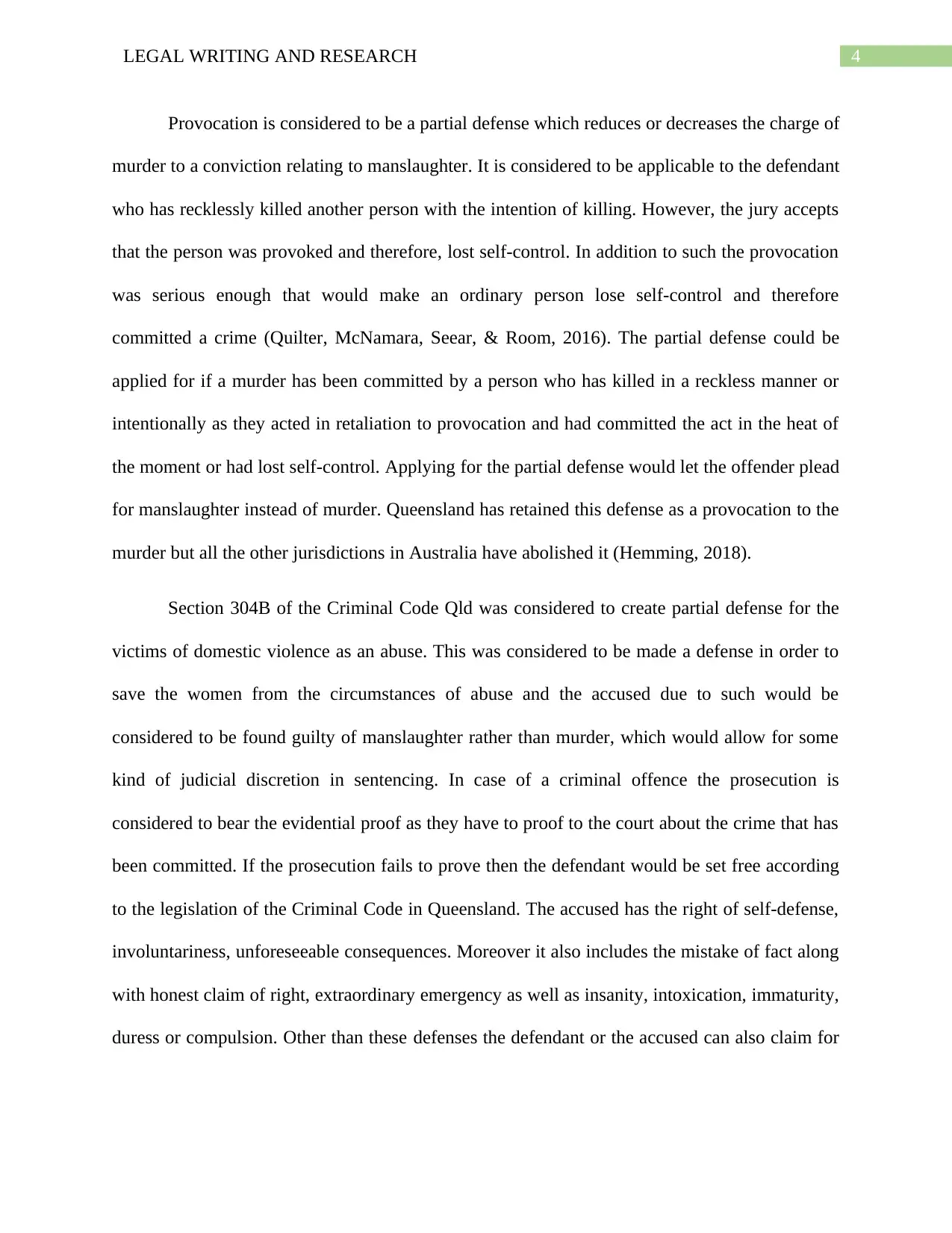
4LEGAL WRITING AND RESEARCH
Provocation is considered to be a partial defense which reduces or decreases the charge of
murder to a conviction relating to manslaughter. It is considered to be applicable to the defendant
who has recklessly killed another person with the intention of killing. However, the jury accepts
that the person was provoked and therefore, lost self-control. In addition to such the provocation
was serious enough that would make an ordinary person lose self-control and therefore
committed a crime (Quilter, McNamara, Seear, & Room, 2016). The partial defense could be
applied for if a murder has been committed by a person who has killed in a reckless manner or
intentionally as they acted in retaliation to provocation and had committed the act in the heat of
the moment or had lost self-control. Applying for the partial defense would let the offender plead
for manslaughter instead of murder. Queensland has retained this defense as a provocation to the
murder but all the other jurisdictions in Australia have abolished it (Hemming, 2018).
Section 304B of the Criminal Code Qld was considered to create partial defense for the
victims of domestic violence as an abuse. This was considered to be made a defense in order to
save the women from the circumstances of abuse and the accused due to such would be
considered to be found guilty of manslaughter rather than murder, which would allow for some
kind of judicial discretion in sentencing. In case of a criminal offence the prosecution is
considered to bear the evidential proof as they have to proof to the court about the crime that has
been committed. If the prosecution fails to prove then the defendant would be set free according
to the legislation of the Criminal Code in Queensland. The accused has the right of self-defense,
involuntariness, unforeseeable consequences. Moreover it also includes the mistake of fact along
with honest claim of right, extraordinary emergency as well as insanity, intoxication, immaturity,
duress or compulsion. Other than these defenses the defendant or the accused can also claim for
Provocation is considered to be a partial defense which reduces or decreases the charge of
murder to a conviction relating to manslaughter. It is considered to be applicable to the defendant
who has recklessly killed another person with the intention of killing. However, the jury accepts
that the person was provoked and therefore, lost self-control. In addition to such the provocation
was serious enough that would make an ordinary person lose self-control and therefore
committed a crime (Quilter, McNamara, Seear, & Room, 2016). The partial defense could be
applied for if a murder has been committed by a person who has killed in a reckless manner or
intentionally as they acted in retaliation to provocation and had committed the act in the heat of
the moment or had lost self-control. Applying for the partial defense would let the offender plead
for manslaughter instead of murder. Queensland has retained this defense as a provocation to the
murder but all the other jurisdictions in Australia have abolished it (Hemming, 2018).
Section 304B of the Criminal Code Qld was considered to create partial defense for the
victims of domestic violence as an abuse. This was considered to be made a defense in order to
save the women from the circumstances of abuse and the accused due to such would be
considered to be found guilty of manslaughter rather than murder, which would allow for some
kind of judicial discretion in sentencing. In case of a criminal offence the prosecution is
considered to bear the evidential proof as they have to proof to the court about the crime that has
been committed. If the prosecution fails to prove then the defendant would be set free according
to the legislation of the Criminal Code in Queensland. The accused has the right of self-defense,
involuntariness, unforeseeable consequences. Moreover it also includes the mistake of fact along
with honest claim of right, extraordinary emergency as well as insanity, intoxication, immaturity,
duress or compulsion. Other than these defenses the defendant or the accused can also claim for
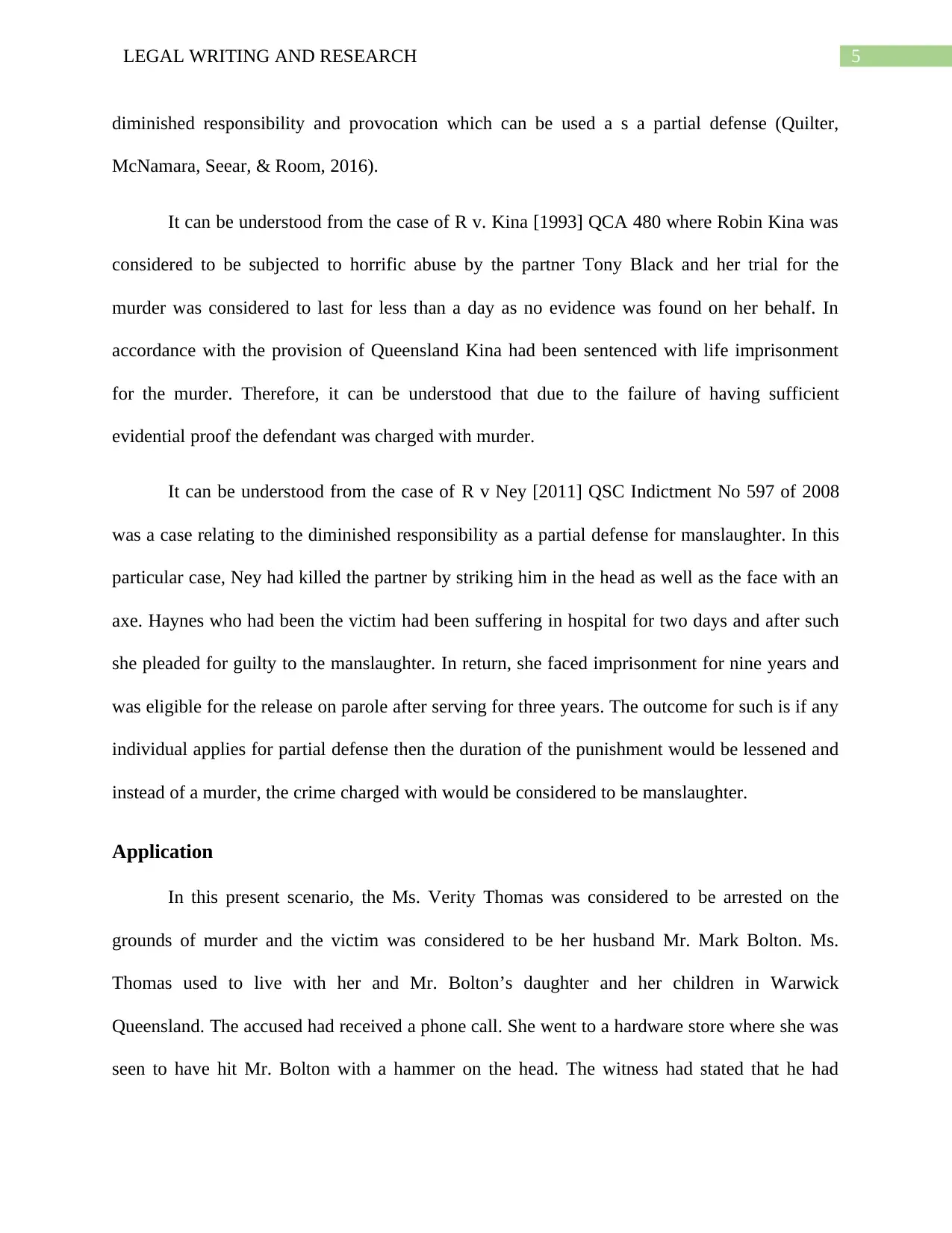
5LEGAL WRITING AND RESEARCH
diminished responsibility and provocation which can be used a s a partial defense (Quilter,
McNamara, Seear, & Room, 2016).
It can be understood from the case of R v. Kina [1993] QCA 480 where Robin Kina was
considered to be subjected to horrific abuse by the partner Tony Black and her trial for the
murder was considered to last for less than a day as no evidence was found on her behalf. In
accordance with the provision of Queensland Kina had been sentenced with life imprisonment
for the murder. Therefore, it can be understood that due to the failure of having sufficient
evidential proof the defendant was charged with murder.
It can be understood from the case of R v Ney [2011] QSC Indictment No 597 of 2008
was a case relating to the diminished responsibility as a partial defense for manslaughter. In this
particular case, Ney had killed the partner by striking him in the head as well as the face with an
axe. Haynes who had been the victim had been suffering in hospital for two days and after such
she pleaded for guilty to the manslaughter. In return, she faced imprisonment for nine years and
was eligible for the release on parole after serving for three years. The outcome for such is if any
individual applies for partial defense then the duration of the punishment would be lessened and
instead of a murder, the crime charged with would be considered to be manslaughter.
Application
In this present scenario, the Ms. Verity Thomas was considered to be arrested on the
grounds of murder and the victim was considered to be her husband Mr. Mark Bolton. Ms.
Thomas used to live with her and Mr. Bolton’s daughter and her children in Warwick
Queensland. The accused had received a phone call. She went to a hardware store where she was
seen to have hit Mr. Bolton with a hammer on the head. The witness had stated that he had
diminished responsibility and provocation which can be used a s a partial defense (Quilter,
McNamara, Seear, & Room, 2016).
It can be understood from the case of R v. Kina [1993] QCA 480 where Robin Kina was
considered to be subjected to horrific abuse by the partner Tony Black and her trial for the
murder was considered to last for less than a day as no evidence was found on her behalf. In
accordance with the provision of Queensland Kina had been sentenced with life imprisonment
for the murder. Therefore, it can be understood that due to the failure of having sufficient
evidential proof the defendant was charged with murder.
It can be understood from the case of R v Ney [2011] QSC Indictment No 597 of 2008
was a case relating to the diminished responsibility as a partial defense for manslaughter. In this
particular case, Ney had killed the partner by striking him in the head as well as the face with an
axe. Haynes who had been the victim had been suffering in hospital for two days and after such
she pleaded for guilty to the manslaughter. In return, she faced imprisonment for nine years and
was eligible for the release on parole after serving for three years. The outcome for such is if any
individual applies for partial defense then the duration of the punishment would be lessened and
instead of a murder, the crime charged with would be considered to be manslaughter.
Application
In this present scenario, the Ms. Verity Thomas was considered to be arrested on the
grounds of murder and the victim was considered to be her husband Mr. Mark Bolton. Ms.
Thomas used to live with her and Mr. Bolton’s daughter and her children in Warwick
Queensland. The accused had received a phone call. She went to a hardware store where she was
seen to have hit Mr. Bolton with a hammer on the head. The witness had stated that he had
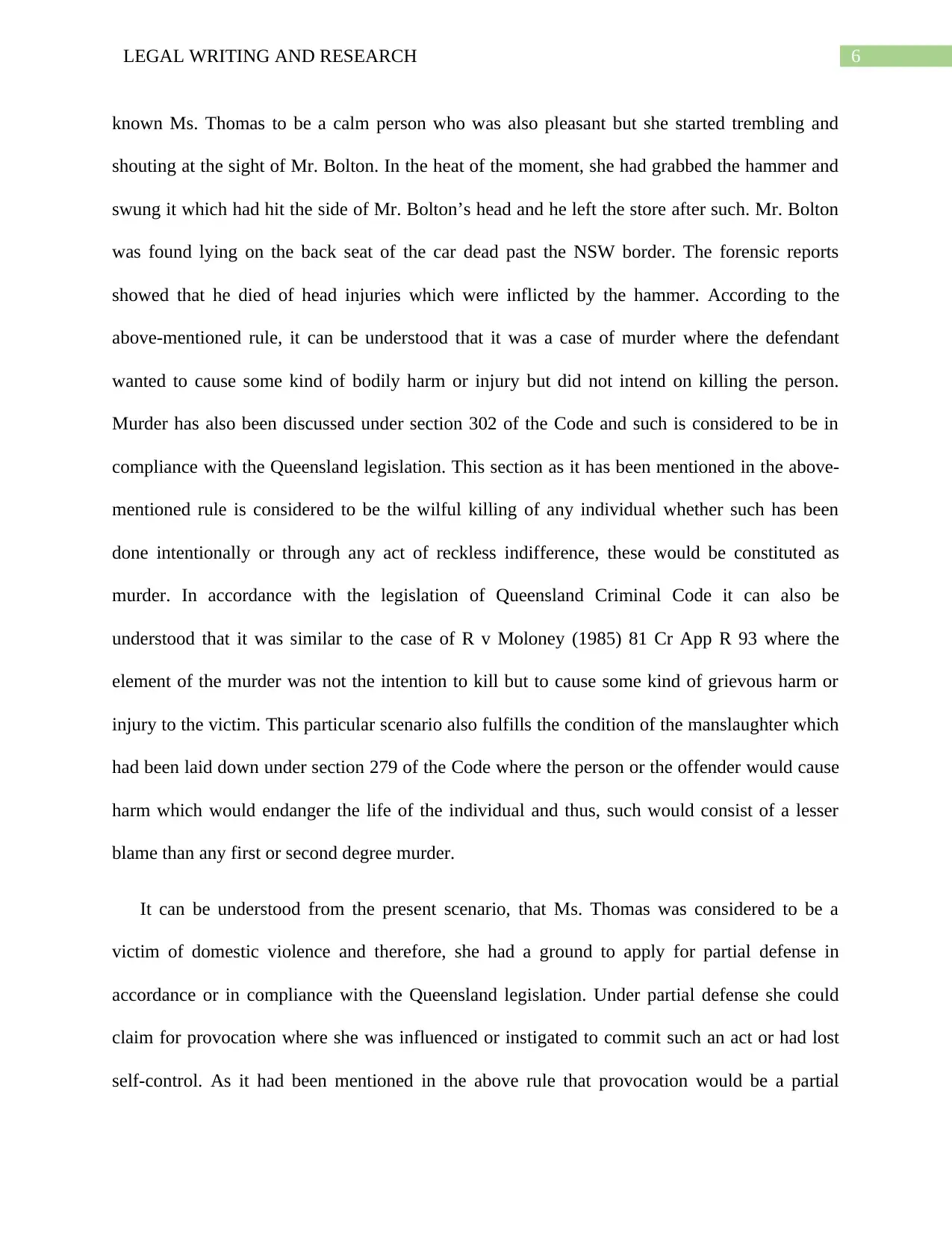
6LEGAL WRITING AND RESEARCH
known Ms. Thomas to be a calm person who was also pleasant but she started trembling and
shouting at the sight of Mr. Bolton. In the heat of the moment, she had grabbed the hammer and
swung it which had hit the side of Mr. Bolton’s head and he left the store after such. Mr. Bolton
was found lying on the back seat of the car dead past the NSW border. The forensic reports
showed that he died of head injuries which were inflicted by the hammer. According to the
above-mentioned rule, it can be understood that it was a case of murder where the defendant
wanted to cause some kind of bodily harm or injury but did not intend on killing the person.
Murder has also been discussed under section 302 of the Code and such is considered to be in
compliance with the Queensland legislation. This section as it has been mentioned in the above-
mentioned rule is considered to be the wilful killing of any individual whether such has been
done intentionally or through any act of reckless indifference, these would be constituted as
murder. In accordance with the legislation of Queensland Criminal Code it can also be
understood that it was similar to the case of R v Moloney (1985) 81 Cr App R 93 where the
element of the murder was not the intention to kill but to cause some kind of grievous harm or
injury to the victim. This particular scenario also fulfills the condition of the manslaughter which
had been laid down under section 279 of the Code where the person or the offender would cause
harm which would endanger the life of the individual and thus, such would consist of a lesser
blame than any first or second degree murder.
It can be understood from the present scenario, that Ms. Thomas was considered to be a
victim of domestic violence and therefore, she had a ground to apply for partial defense in
accordance or in compliance with the Queensland legislation. Under partial defense she could
claim for provocation where she was influenced or instigated to commit such an act or had lost
self-control. As it had been mentioned in the above rule that provocation would be a partial
known Ms. Thomas to be a calm person who was also pleasant but she started trembling and
shouting at the sight of Mr. Bolton. In the heat of the moment, she had grabbed the hammer and
swung it which had hit the side of Mr. Bolton’s head and he left the store after such. Mr. Bolton
was found lying on the back seat of the car dead past the NSW border. The forensic reports
showed that he died of head injuries which were inflicted by the hammer. According to the
above-mentioned rule, it can be understood that it was a case of murder where the defendant
wanted to cause some kind of bodily harm or injury but did not intend on killing the person.
Murder has also been discussed under section 302 of the Code and such is considered to be in
compliance with the Queensland legislation. This section as it has been mentioned in the above-
mentioned rule is considered to be the wilful killing of any individual whether such has been
done intentionally or through any act of reckless indifference, these would be constituted as
murder. In accordance with the legislation of Queensland Criminal Code it can also be
understood that it was similar to the case of R v Moloney (1985) 81 Cr App R 93 where the
element of the murder was not the intention to kill but to cause some kind of grievous harm or
injury to the victim. This particular scenario also fulfills the condition of the manslaughter which
had been laid down under section 279 of the Code where the person or the offender would cause
harm which would endanger the life of the individual and thus, such would consist of a lesser
blame than any first or second degree murder.
It can be understood from the present scenario, that Ms. Thomas was considered to be a
victim of domestic violence and therefore, she had a ground to apply for partial defense in
accordance or in compliance with the Queensland legislation. Under partial defense she could
claim for provocation where she was influenced or instigated to commit such an act or had lost
self-control. As it had been mentioned in the above rule that provocation would be a partial
Paraphrase This Document
Need a fresh take? Get an instant paraphrase of this document with our AI Paraphraser
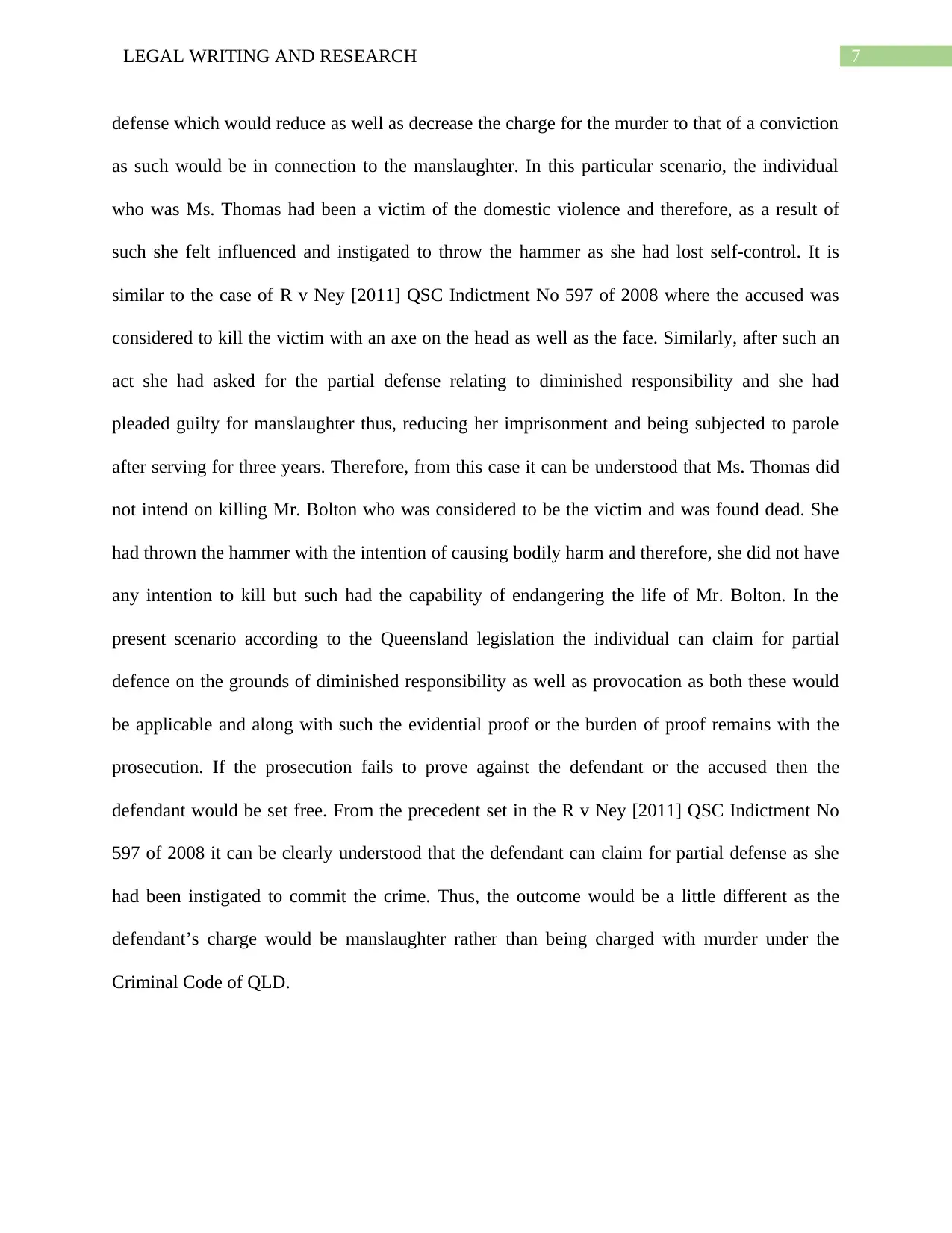
7LEGAL WRITING AND RESEARCH
defense which would reduce as well as decrease the charge for the murder to that of a conviction
as such would be in connection to the manslaughter. In this particular scenario, the individual
who was Ms. Thomas had been a victim of the domestic violence and therefore, as a result of
such she felt influenced and instigated to throw the hammer as she had lost self-control. It is
similar to the case of R v Ney [2011] QSC Indictment No 597 of 2008 where the accused was
considered to kill the victim with an axe on the head as well as the face. Similarly, after such an
act she had asked for the partial defense relating to diminished responsibility and she had
pleaded guilty for manslaughter thus, reducing her imprisonment and being subjected to parole
after serving for three years. Therefore, from this case it can be understood that Ms. Thomas did
not intend on killing Mr. Bolton who was considered to be the victim and was found dead. She
had thrown the hammer with the intention of causing bodily harm and therefore, she did not have
any intention to kill but such had the capability of endangering the life of Mr. Bolton. In the
present scenario according to the Queensland legislation the individual can claim for partial
defence on the grounds of diminished responsibility as well as provocation as both these would
be applicable and along with such the evidential proof or the burden of proof remains with the
prosecution. If the prosecution fails to prove against the defendant or the accused then the
defendant would be set free. From the precedent set in the R v Ney [2011] QSC Indictment No
597 of 2008 it can be clearly understood that the defendant can claim for partial defense as she
had been instigated to commit the crime. Thus, the outcome would be a little different as the
defendant’s charge would be manslaughter rather than being charged with murder under the
Criminal Code of QLD.
defense which would reduce as well as decrease the charge for the murder to that of a conviction
as such would be in connection to the manslaughter. In this particular scenario, the individual
who was Ms. Thomas had been a victim of the domestic violence and therefore, as a result of
such she felt influenced and instigated to throw the hammer as she had lost self-control. It is
similar to the case of R v Ney [2011] QSC Indictment No 597 of 2008 where the accused was
considered to kill the victim with an axe on the head as well as the face. Similarly, after such an
act she had asked for the partial defense relating to diminished responsibility and she had
pleaded guilty for manslaughter thus, reducing her imprisonment and being subjected to parole
after serving for three years. Therefore, from this case it can be understood that Ms. Thomas did
not intend on killing Mr. Bolton who was considered to be the victim and was found dead. She
had thrown the hammer with the intention of causing bodily harm and therefore, she did not have
any intention to kill but such had the capability of endangering the life of Mr. Bolton. In the
present scenario according to the Queensland legislation the individual can claim for partial
defence on the grounds of diminished responsibility as well as provocation as both these would
be applicable and along with such the evidential proof or the burden of proof remains with the
prosecution. If the prosecution fails to prove against the defendant or the accused then the
defendant would be set free. From the precedent set in the R v Ney [2011] QSC Indictment No
597 of 2008 it can be clearly understood that the defendant can claim for partial defense as she
had been instigated to commit the crime. Thus, the outcome would be a little different as the
defendant’s charge would be manslaughter rather than being charged with murder under the
Criminal Code of QLD.
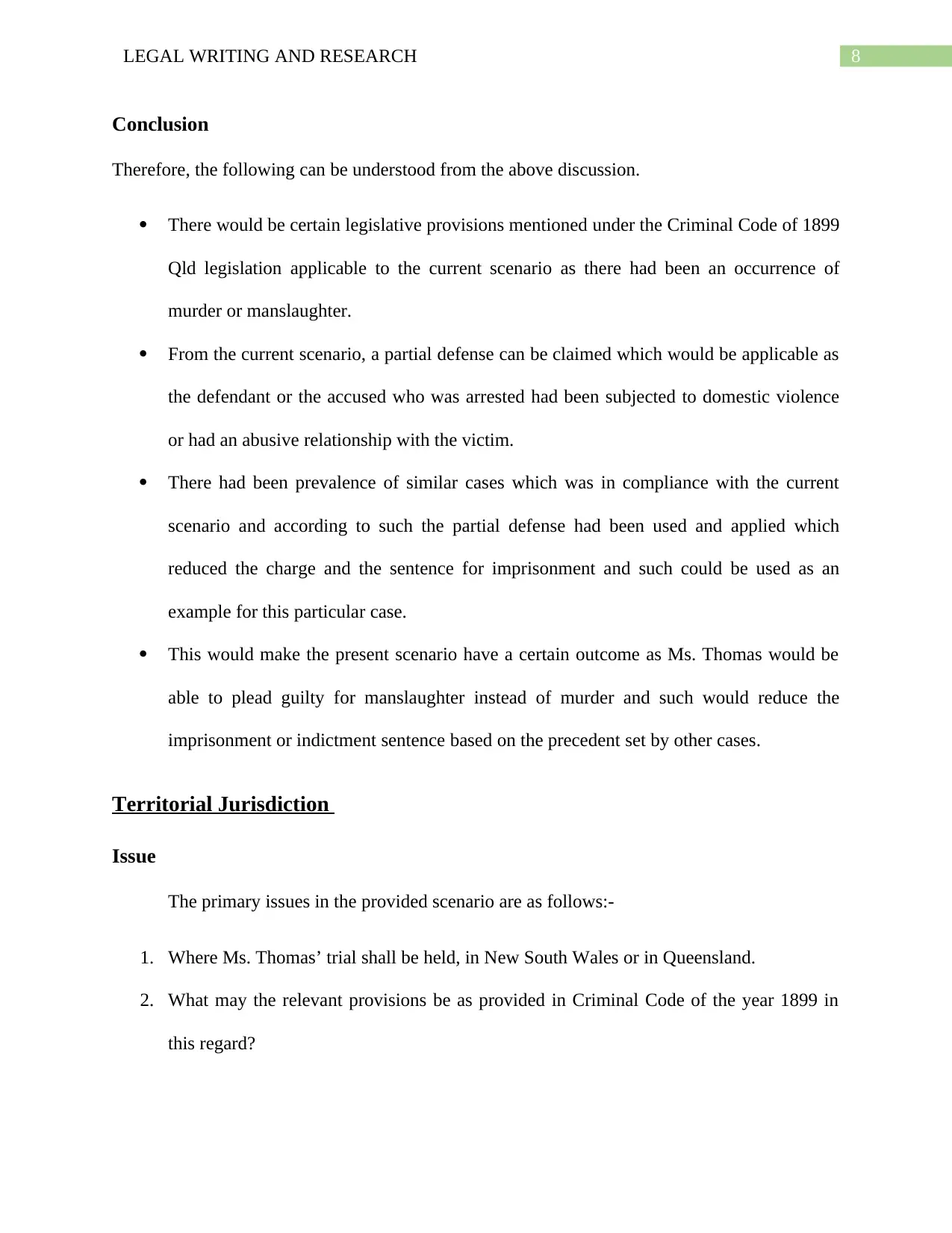
8LEGAL WRITING AND RESEARCH
Conclusion
Therefore, the following can be understood from the above discussion.
There would be certain legislative provisions mentioned under the Criminal Code of 1899
Qld legislation applicable to the current scenario as there had been an occurrence of
murder or manslaughter.
From the current scenario, a partial defense can be claimed which would be applicable as
the defendant or the accused who was arrested had been subjected to domestic violence
or had an abusive relationship with the victim.
There had been prevalence of similar cases which was in compliance with the current
scenario and according to such the partial defense had been used and applied which
reduced the charge and the sentence for imprisonment and such could be used as an
example for this particular case.
This would make the present scenario have a certain outcome as Ms. Thomas would be
able to plead guilty for manslaughter instead of murder and such would reduce the
imprisonment or indictment sentence based on the precedent set by other cases.
Territorial Jurisdiction
Issue
The primary issues in the provided scenario are as follows:-
1. Where Ms. Thomas’ trial shall be held, in New South Wales or in Queensland.
2. What may the relevant provisions be as provided in Criminal Code of the year 1899 in
this regard?
Conclusion
Therefore, the following can be understood from the above discussion.
There would be certain legislative provisions mentioned under the Criminal Code of 1899
Qld legislation applicable to the current scenario as there had been an occurrence of
murder or manslaughter.
From the current scenario, a partial defense can be claimed which would be applicable as
the defendant or the accused who was arrested had been subjected to domestic violence
or had an abusive relationship with the victim.
There had been prevalence of similar cases which was in compliance with the current
scenario and according to such the partial defense had been used and applied which
reduced the charge and the sentence for imprisonment and such could be used as an
example for this particular case.
This would make the present scenario have a certain outcome as Ms. Thomas would be
able to plead guilty for manslaughter instead of murder and such would reduce the
imprisonment or indictment sentence based on the precedent set by other cases.
Territorial Jurisdiction
Issue
The primary issues in the provided scenario are as follows:-
1. Where Ms. Thomas’ trial shall be held, in New South Wales or in Queensland.
2. What may the relevant provisions be as provided in Criminal Code of the year 1899 in
this regard?
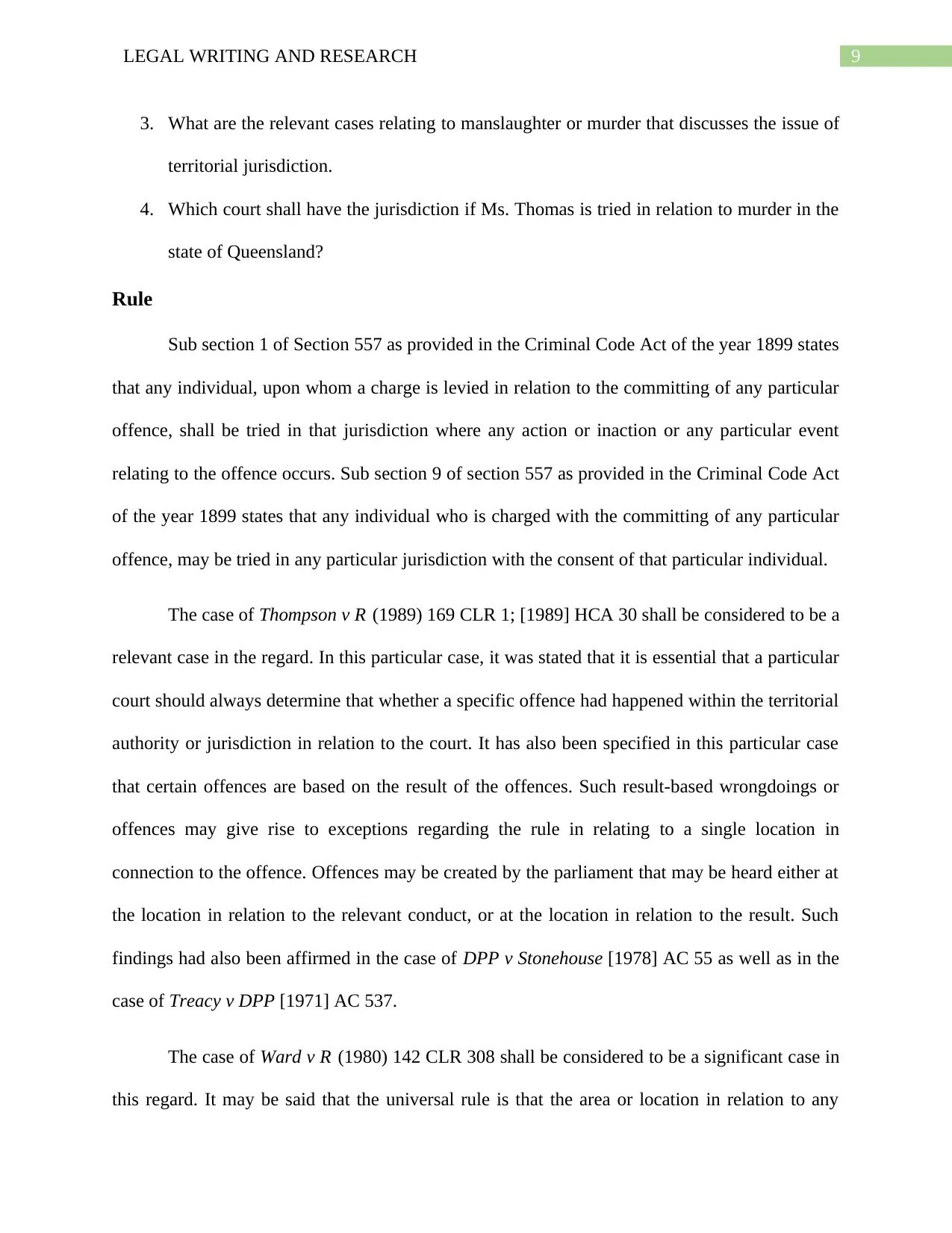
9LEGAL WRITING AND RESEARCH
3. What are the relevant cases relating to manslaughter or murder that discusses the issue of
territorial jurisdiction.
4. Which court shall have the jurisdiction if Ms. Thomas is tried in relation to murder in the
state of Queensland?
Rule
Sub section 1 of Section 557 as provided in the Criminal Code Act of the year 1899 states
that any individual, upon whom a charge is levied in relation to the committing of any particular
offence, shall be tried in that jurisdiction where any action or inaction or any particular event
relating to the offence occurs. Sub section 9 of section 557 as provided in the Criminal Code Act
of the year 1899 states that any individual who is charged with the committing of any particular
offence, may be tried in any particular jurisdiction with the consent of that particular individual.
The case of Thompson v R (1989) 169 CLR 1; [1989] HCA 30 shall be considered to be a
relevant case in the regard. In this particular case, it was stated that it is essential that a particular
court should always determine that whether a specific offence had happened within the territorial
authority or jurisdiction in relation to the court. It has also been specified in this particular case
that certain offences are based on the result of the offences. Such result-based wrongdoings or
offences may give rise to exceptions regarding the rule in relating to a single location in
connection to the offence. Offences may be created by the parliament that may be heard either at
the location in relation to the relevant conduct, or at the location in relation to the result. Such
findings had also been affirmed in the case of DPP v Stonehouse [1978] AC 55 as well as in the
case of Treacy v DPP [1971] AC 537.
The case of Ward v R (1980) 142 CLR 308 shall be considered to be a significant case in
this regard. It may be said that the universal rule is that the area or location in relation to any
3. What are the relevant cases relating to manslaughter or murder that discusses the issue of
territorial jurisdiction.
4. Which court shall have the jurisdiction if Ms. Thomas is tried in relation to murder in the
state of Queensland?
Rule
Sub section 1 of Section 557 as provided in the Criminal Code Act of the year 1899 states
that any individual, upon whom a charge is levied in relation to the committing of any particular
offence, shall be tried in that jurisdiction where any action or inaction or any particular event
relating to the offence occurs. Sub section 9 of section 557 as provided in the Criminal Code Act
of the year 1899 states that any individual who is charged with the committing of any particular
offence, may be tried in any particular jurisdiction with the consent of that particular individual.
The case of Thompson v R (1989) 169 CLR 1; [1989] HCA 30 shall be considered to be a
relevant case in the regard. In this particular case, it was stated that it is essential that a particular
court should always determine that whether a specific offence had happened within the territorial
authority or jurisdiction in relation to the court. It has also been specified in this particular case
that certain offences are based on the result of the offences. Such result-based wrongdoings or
offences may give rise to exceptions regarding the rule in relating to a single location in
connection to the offence. Offences may be created by the parliament that may be heard either at
the location in relation to the relevant conduct, or at the location in relation to the result. Such
findings had also been affirmed in the case of DPP v Stonehouse [1978] AC 55 as well as in the
case of Treacy v DPP [1971] AC 537.
The case of Ward v R (1980) 142 CLR 308 shall be considered to be a significant case in
this regard. It may be said that the universal rule is that the area or location in relation to any
Secure Best Marks with AI Grader
Need help grading? Try our AI Grader for instant feedback on your assignments.
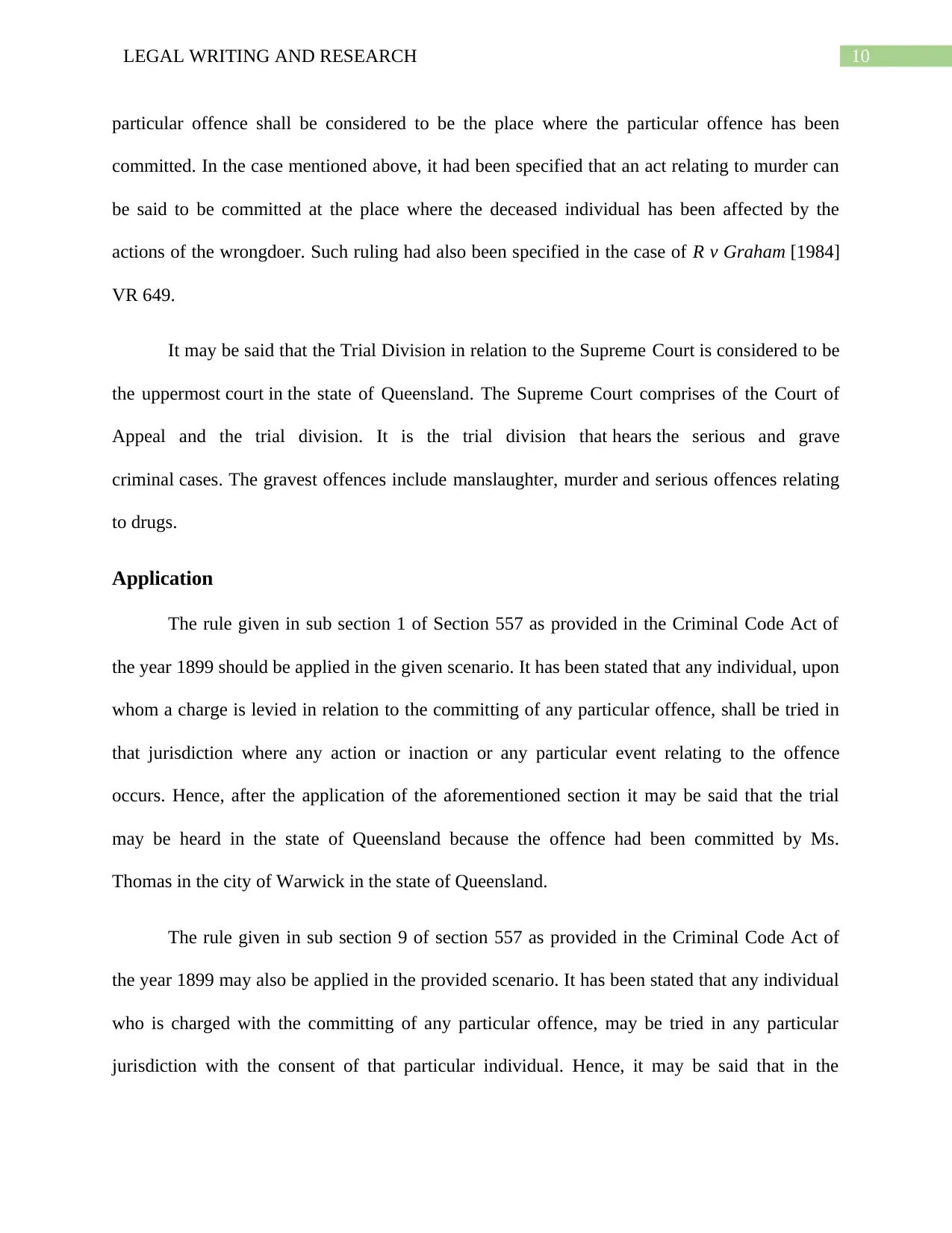
10LEGAL WRITING AND RESEARCH
particular offence shall be considered to be the place where the particular offence has been
committed. In the case mentioned above, it had been specified that an act relating to murder can
be said to be committed at the place where the deceased individual has been affected by the
actions of the wrongdoer. Such ruling had also been specified in the case of R v Graham [1984]
VR 649.
It may be said that the Trial Division in relation to the Supreme Court is considered to be
the uppermost court in the state of Queensland. The Supreme Court comprises of the Court of
Appeal and the trial division. It is the trial division that hears the serious and grave
criminal cases. The gravest offences include manslaughter, murder and serious offences relating
to drugs.
Application
The rule given in sub section 1 of Section 557 as provided in the Criminal Code Act of
the year 1899 should be applied in the given scenario. It has been stated that any individual, upon
whom a charge is levied in relation to the committing of any particular offence, shall be tried in
that jurisdiction where any action or inaction or any particular event relating to the offence
occurs. Hence, after the application of the aforementioned section it may be said that the trial
may be heard in the state of Queensland because the offence had been committed by Ms.
Thomas in the city of Warwick in the state of Queensland.
The rule given in sub section 9 of section 557 as provided in the Criminal Code Act of
the year 1899 may also be applied in the provided scenario. It has been stated that any individual
who is charged with the committing of any particular offence, may be tried in any particular
jurisdiction with the consent of that particular individual. Hence, it may be said that in the
particular offence shall be considered to be the place where the particular offence has been
committed. In the case mentioned above, it had been specified that an act relating to murder can
be said to be committed at the place where the deceased individual has been affected by the
actions of the wrongdoer. Such ruling had also been specified in the case of R v Graham [1984]
VR 649.
It may be said that the Trial Division in relation to the Supreme Court is considered to be
the uppermost court in the state of Queensland. The Supreme Court comprises of the Court of
Appeal and the trial division. It is the trial division that hears the serious and grave
criminal cases. The gravest offences include manslaughter, murder and serious offences relating
to drugs.
Application
The rule given in sub section 1 of Section 557 as provided in the Criminal Code Act of
the year 1899 should be applied in the given scenario. It has been stated that any individual, upon
whom a charge is levied in relation to the committing of any particular offence, shall be tried in
that jurisdiction where any action or inaction or any particular event relating to the offence
occurs. Hence, after the application of the aforementioned section it may be said that the trial
may be heard in the state of Queensland because the offence had been committed by Ms.
Thomas in the city of Warwick in the state of Queensland.
The rule given in sub section 9 of section 557 as provided in the Criminal Code Act of
the year 1899 may also be applied in the provided scenario. It has been stated that any individual
who is charged with the committing of any particular offence, may be tried in any particular
jurisdiction with the consent of that particular individual. Hence, it may be said that in the
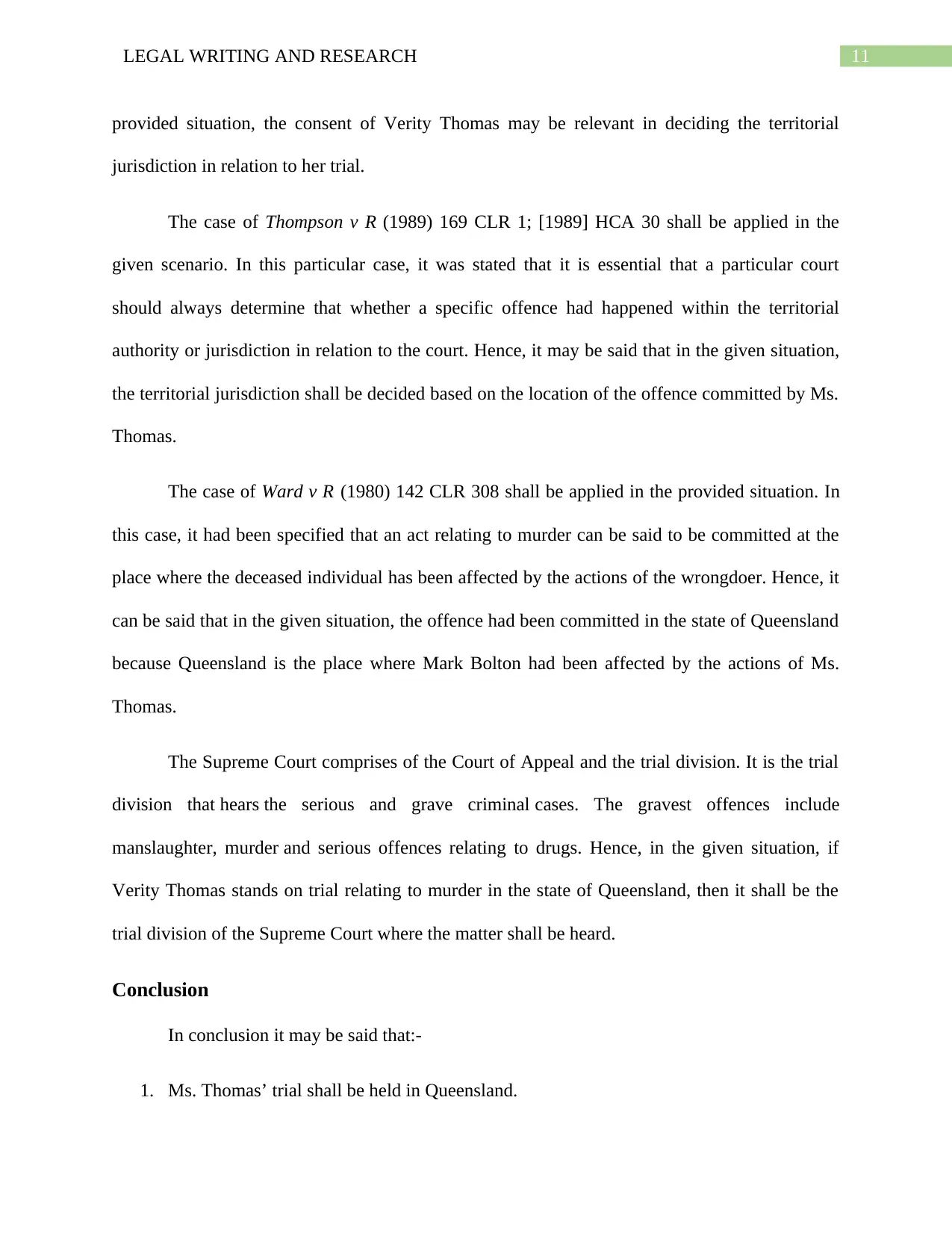
11LEGAL WRITING AND RESEARCH
provided situation, the consent of Verity Thomas may be relevant in deciding the territorial
jurisdiction in relation to her trial.
The case of Thompson v R (1989) 169 CLR 1; [1989] HCA 30 shall be applied in the
given scenario. In this particular case, it was stated that it is essential that a particular court
should always determine that whether a specific offence had happened within the territorial
authority or jurisdiction in relation to the court. Hence, it may be said that in the given situation,
the territorial jurisdiction shall be decided based on the location of the offence committed by Ms.
Thomas.
The case of Ward v R (1980) 142 CLR 308 shall be applied in the provided situation. In
this case, it had been specified that an act relating to murder can be said to be committed at the
place where the deceased individual has been affected by the actions of the wrongdoer. Hence, it
can be said that in the given situation, the offence had been committed in the state of Queensland
because Queensland is the place where Mark Bolton had been affected by the actions of Ms.
Thomas.
The Supreme Court comprises of the Court of Appeal and the trial division. It is the trial
division that hears the serious and grave criminal cases. The gravest offences include
manslaughter, murder and serious offences relating to drugs. Hence, in the given situation, if
Verity Thomas stands on trial relating to murder in the state of Queensland, then it shall be the
trial division of the Supreme Court where the matter shall be heard.
Conclusion
In conclusion it may be said that:-
1. Ms. Thomas’ trial shall be held in Queensland.
provided situation, the consent of Verity Thomas may be relevant in deciding the territorial
jurisdiction in relation to her trial.
The case of Thompson v R (1989) 169 CLR 1; [1989] HCA 30 shall be applied in the
given scenario. In this particular case, it was stated that it is essential that a particular court
should always determine that whether a specific offence had happened within the territorial
authority or jurisdiction in relation to the court. Hence, it may be said that in the given situation,
the territorial jurisdiction shall be decided based on the location of the offence committed by Ms.
Thomas.
The case of Ward v R (1980) 142 CLR 308 shall be applied in the provided situation. In
this case, it had been specified that an act relating to murder can be said to be committed at the
place where the deceased individual has been affected by the actions of the wrongdoer. Hence, it
can be said that in the given situation, the offence had been committed in the state of Queensland
because Queensland is the place where Mark Bolton had been affected by the actions of Ms.
Thomas.
The Supreme Court comprises of the Court of Appeal and the trial division. It is the trial
division that hears the serious and grave criminal cases. The gravest offences include
manslaughter, murder and serious offences relating to drugs. Hence, in the given situation, if
Verity Thomas stands on trial relating to murder in the state of Queensland, then it shall be the
trial division of the Supreme Court where the matter shall be heard.
Conclusion
In conclusion it may be said that:-
1. Ms. Thomas’ trial shall be held in Queensland.
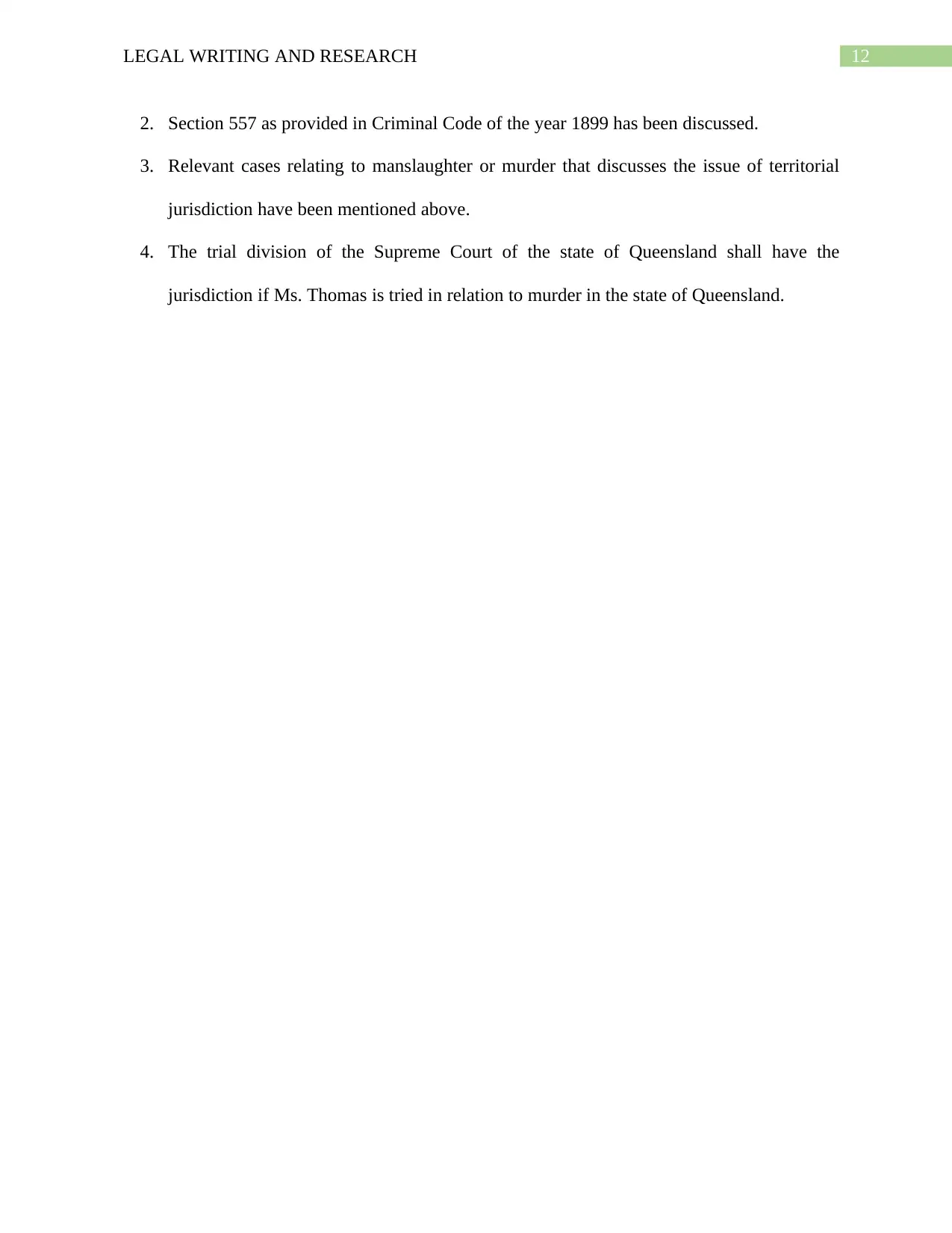
12LEGAL WRITING AND RESEARCH
2. Section 557 as provided in Criminal Code of the year 1899 has been discussed.
3. Relevant cases relating to manslaughter or murder that discusses the issue of territorial
jurisdiction have been mentioned above.
4. The trial division of the Supreme Court of the state of Queensland shall have the
jurisdiction if Ms. Thomas is tried in relation to murder in the state of Queensland.
2. Section 557 as provided in Criminal Code of the year 1899 has been discussed.
3. Relevant cases relating to manslaughter or murder that discusses the issue of territorial
jurisdiction have been mentioned above.
4. The trial division of the Supreme Court of the state of Queensland shall have the
jurisdiction if Ms. Thomas is tried in relation to murder in the state of Queensland.
Paraphrase This Document
Need a fresh take? Get an instant paraphrase of this document with our AI Paraphraser
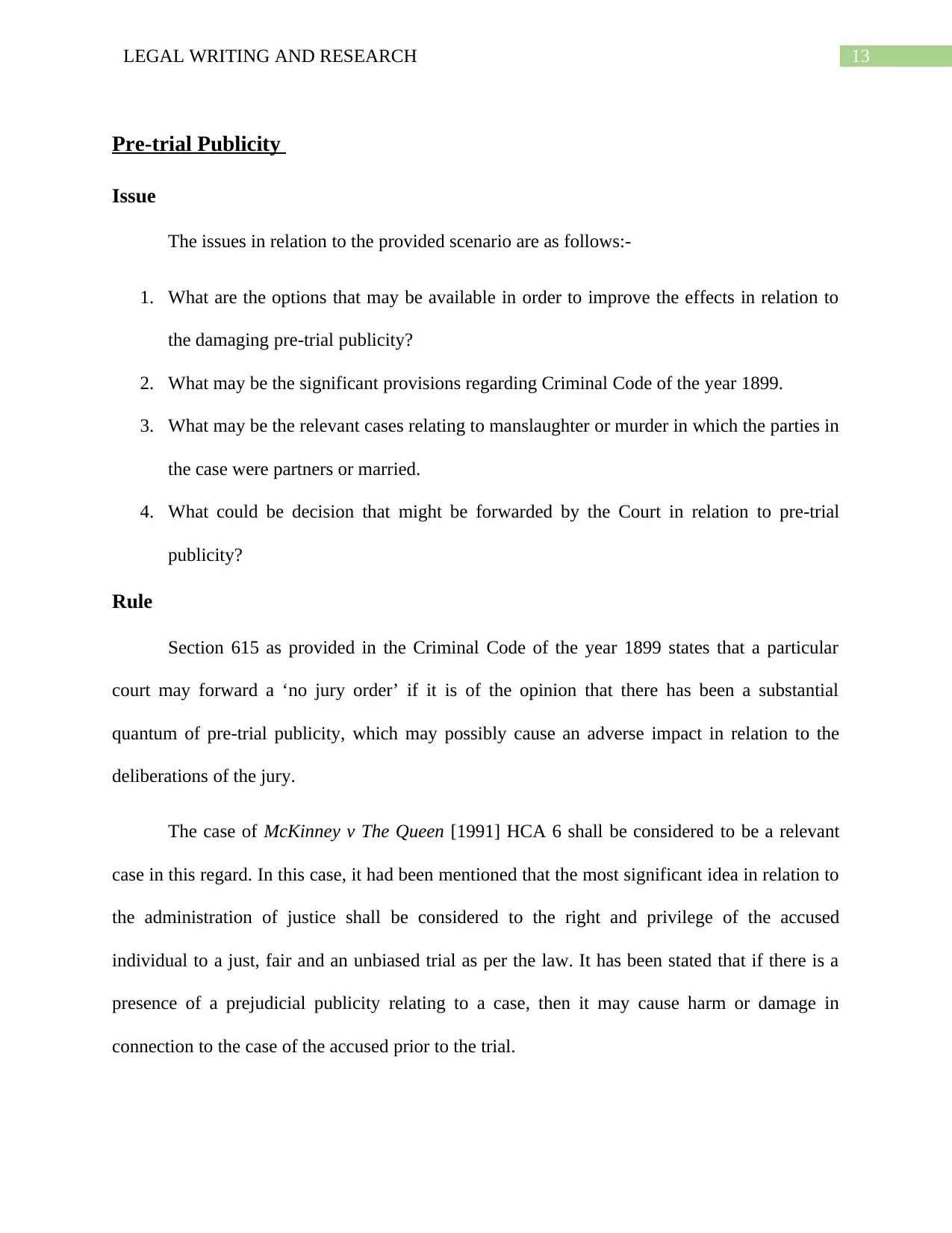
13LEGAL WRITING AND RESEARCH
Pre-trial Publicity
Issue
The issues in relation to the provided scenario are as follows:-
1. What are the options that may be available in order to improve the effects in relation to
the damaging pre-trial publicity?
2. What may be the significant provisions regarding Criminal Code of the year 1899.
3. What may be the relevant cases relating to manslaughter or murder in which the parties in
the case were partners or married.
4. What could be decision that might be forwarded by the Court in relation to pre-trial
publicity?
Rule
Section 615 as provided in the Criminal Code of the year 1899 states that a particular
court may forward a ‘no jury order’ if it is of the opinion that there has been a substantial
quantum of pre-trial publicity, which may possibly cause an adverse impact in relation to the
deliberations of the jury.
The case of McKinney v The Queen [1991] HCA 6 shall be considered to be a relevant
case in this regard. In this case, it had been mentioned that the most significant idea in relation to
the administration of justice shall be considered to the right and privilege of the accused
individual to a just, fair and an unbiased trial as per the law. It has been stated that if there is a
presence of a prejudicial publicity relating to a case, then it may cause harm or damage in
connection to the case of the accused prior to the trial.
Pre-trial Publicity
Issue
The issues in relation to the provided scenario are as follows:-
1. What are the options that may be available in order to improve the effects in relation to
the damaging pre-trial publicity?
2. What may be the significant provisions regarding Criminal Code of the year 1899.
3. What may be the relevant cases relating to manslaughter or murder in which the parties in
the case were partners or married.
4. What could be decision that might be forwarded by the Court in relation to pre-trial
publicity?
Rule
Section 615 as provided in the Criminal Code of the year 1899 states that a particular
court may forward a ‘no jury order’ if it is of the opinion that there has been a substantial
quantum of pre-trial publicity, which may possibly cause an adverse impact in relation to the
deliberations of the jury.
The case of McKinney v The Queen [1991] HCA 6 shall be considered to be a relevant
case in this regard. In this case, it had been mentioned that the most significant idea in relation to
the administration of justice shall be considered to the right and privilege of the accused
individual to a just, fair and an unbiased trial as per the law. It has been stated that if there is a
presence of a prejudicial publicity relating to a case, then it may cause harm or damage in
connection to the case of the accused prior to the trial.
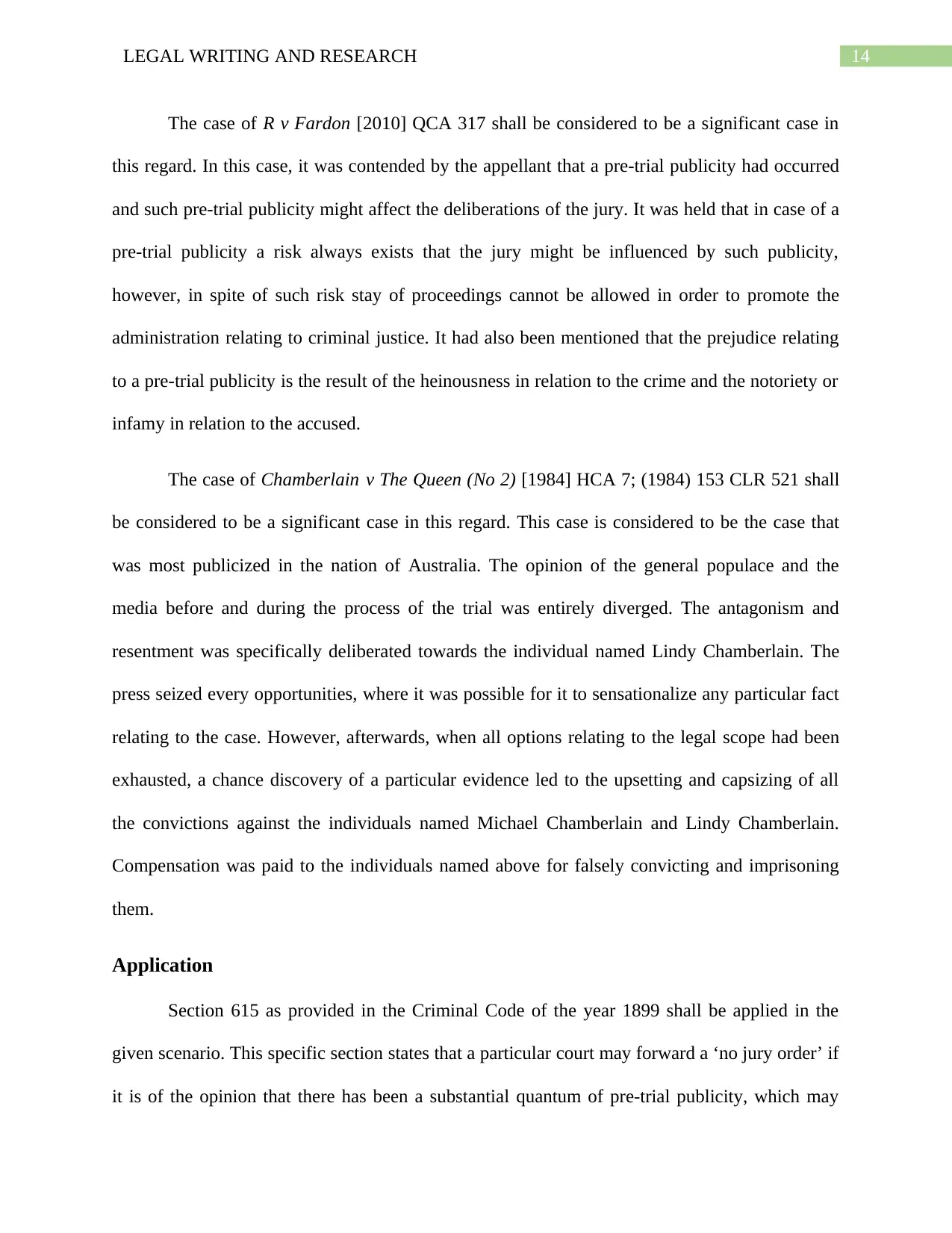
14LEGAL WRITING AND RESEARCH
The case of R v Fardon [2010] QCA 317 shall be considered to be a significant case in
this regard. In this case, it was contended by the appellant that a pre-trial publicity had occurred
and such pre-trial publicity might affect the deliberations of the jury. It was held that in case of a
pre-trial publicity a risk always exists that the jury might be influenced by such publicity,
however, in spite of such risk stay of proceedings cannot be allowed in order to promote the
administration relating to criminal justice. It had also been mentioned that the prejudice relating
to a pre-trial publicity is the result of the heinousness in relation to the crime and the notoriety or
infamy in relation to the accused.
The case of Chamberlain v The Queen (No 2) [1984] HCA 7; (1984) 153 CLR 521 shall
be considered to be a significant case in this regard. This case is considered to be the case that
was most publicized in the nation of Australia. The opinion of the general populace and the
media before and during the process of the trial was entirely diverged. The antagonism and
resentment was specifically deliberated towards the individual named Lindy Chamberlain. The
press seized every opportunities, where it was possible for it to sensationalize any particular fact
relating to the case. However, afterwards, when all options relating to the legal scope had been
exhausted, a chance discovery of a particular evidence led to the upsetting and capsizing of all
the convictions against the individuals named Michael Chamberlain and Lindy Chamberlain.
Compensation was paid to the individuals named above for falsely convicting and imprisoning
them.
Application
Section 615 as provided in the Criminal Code of the year 1899 shall be applied in the
given scenario. This specific section states that a particular court may forward a ‘no jury order’ if
it is of the opinion that there has been a substantial quantum of pre-trial publicity, which may
The case of R v Fardon [2010] QCA 317 shall be considered to be a significant case in
this regard. In this case, it was contended by the appellant that a pre-trial publicity had occurred
and such pre-trial publicity might affect the deliberations of the jury. It was held that in case of a
pre-trial publicity a risk always exists that the jury might be influenced by such publicity,
however, in spite of such risk stay of proceedings cannot be allowed in order to promote the
administration relating to criminal justice. It had also been mentioned that the prejudice relating
to a pre-trial publicity is the result of the heinousness in relation to the crime and the notoriety or
infamy in relation to the accused.
The case of Chamberlain v The Queen (No 2) [1984] HCA 7; (1984) 153 CLR 521 shall
be considered to be a significant case in this regard. This case is considered to be the case that
was most publicized in the nation of Australia. The opinion of the general populace and the
media before and during the process of the trial was entirely diverged. The antagonism and
resentment was specifically deliberated towards the individual named Lindy Chamberlain. The
press seized every opportunities, where it was possible for it to sensationalize any particular fact
relating to the case. However, afterwards, when all options relating to the legal scope had been
exhausted, a chance discovery of a particular evidence led to the upsetting and capsizing of all
the convictions against the individuals named Michael Chamberlain and Lindy Chamberlain.
Compensation was paid to the individuals named above for falsely convicting and imprisoning
them.
Application
Section 615 as provided in the Criminal Code of the year 1899 shall be applied in the
given scenario. This specific section states that a particular court may forward a ‘no jury order’ if
it is of the opinion that there has been a substantial quantum of pre-trial publicity, which may
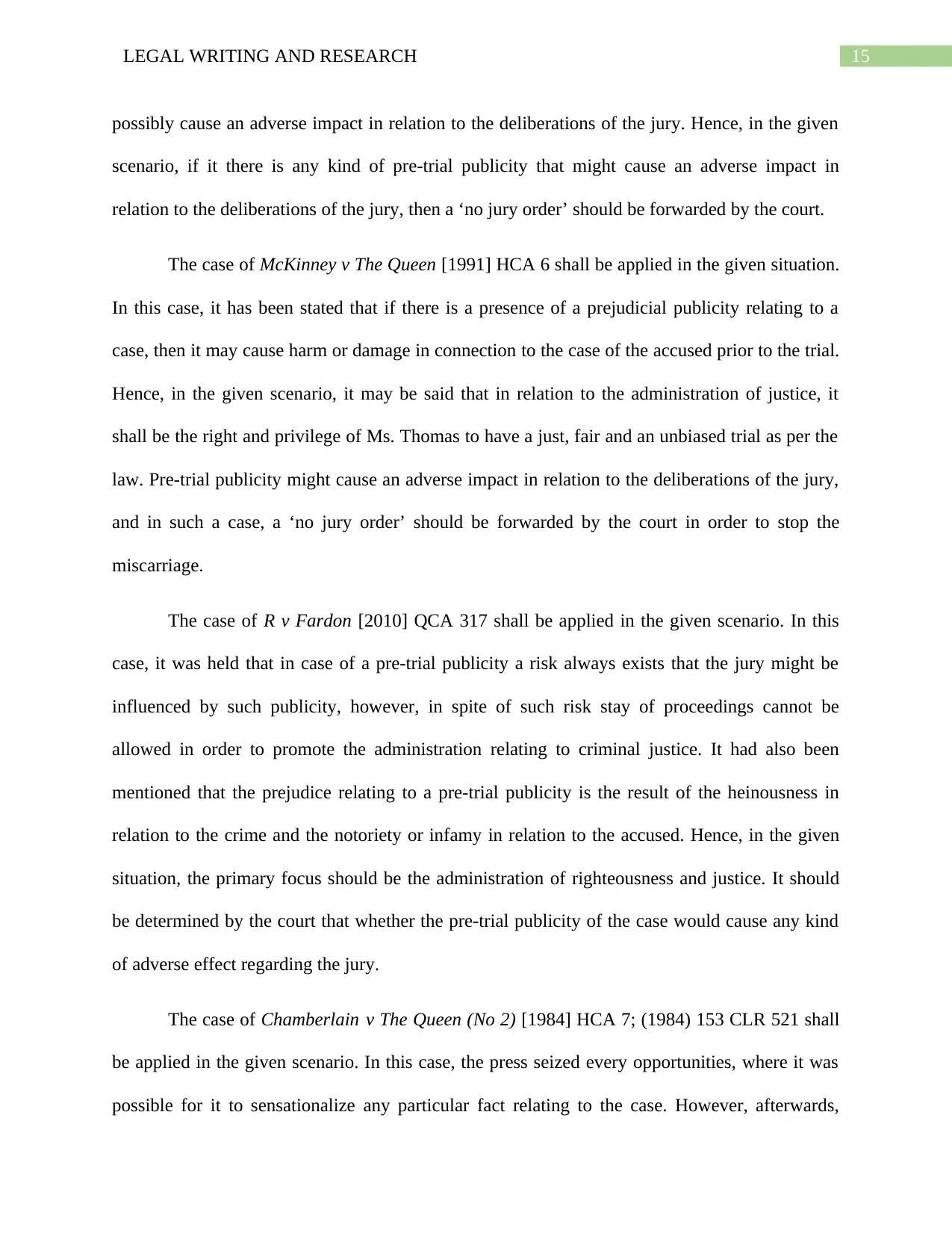
15LEGAL WRITING AND RESEARCH
possibly cause an adverse impact in relation to the deliberations of the jury. Hence, in the given
scenario, if it there is any kind of pre-trial publicity that might cause an adverse impact in
relation to the deliberations of the jury, then a ‘no jury order’ should be forwarded by the court.
The case of McKinney v The Queen [1991] HCA 6 shall be applied in the given situation.
In this case, it has been stated that if there is a presence of a prejudicial publicity relating to a
case, then it may cause harm or damage in connection to the case of the accused prior to the trial.
Hence, in the given scenario, it may be said that in relation to the administration of justice, it
shall be the right and privilege of Ms. Thomas to have a just, fair and an unbiased trial as per the
law. Pre-trial publicity might cause an adverse impact in relation to the deliberations of the jury,
and in such a case, a ‘no jury order’ should be forwarded by the court in order to stop the
miscarriage.
The case of R v Fardon [2010] QCA 317 shall be applied in the given scenario. In this
case, it was held that in case of a pre-trial publicity a risk always exists that the jury might be
influenced by such publicity, however, in spite of such risk stay of proceedings cannot be
allowed in order to promote the administration relating to criminal justice. It had also been
mentioned that the prejudice relating to a pre-trial publicity is the result of the heinousness in
relation to the crime and the notoriety or infamy in relation to the accused. Hence, in the given
situation, the primary focus should be the administration of righteousness and justice. It should
be determined by the court that whether the pre-trial publicity of the case would cause any kind
of adverse effect regarding the jury.
The case of Chamberlain v The Queen (No 2) [1984] HCA 7; (1984) 153 CLR 521 shall
be applied in the given scenario. In this case, the press seized every opportunities, where it was
possible for it to sensationalize any particular fact relating to the case. However, afterwards,
possibly cause an adverse impact in relation to the deliberations of the jury. Hence, in the given
scenario, if it there is any kind of pre-trial publicity that might cause an adverse impact in
relation to the deliberations of the jury, then a ‘no jury order’ should be forwarded by the court.
The case of McKinney v The Queen [1991] HCA 6 shall be applied in the given situation.
In this case, it has been stated that if there is a presence of a prejudicial publicity relating to a
case, then it may cause harm or damage in connection to the case of the accused prior to the trial.
Hence, in the given scenario, it may be said that in relation to the administration of justice, it
shall be the right and privilege of Ms. Thomas to have a just, fair and an unbiased trial as per the
law. Pre-trial publicity might cause an adverse impact in relation to the deliberations of the jury,
and in such a case, a ‘no jury order’ should be forwarded by the court in order to stop the
miscarriage.
The case of R v Fardon [2010] QCA 317 shall be applied in the given scenario. In this
case, it was held that in case of a pre-trial publicity a risk always exists that the jury might be
influenced by such publicity, however, in spite of such risk stay of proceedings cannot be
allowed in order to promote the administration relating to criminal justice. It had also been
mentioned that the prejudice relating to a pre-trial publicity is the result of the heinousness in
relation to the crime and the notoriety or infamy in relation to the accused. Hence, in the given
situation, the primary focus should be the administration of righteousness and justice. It should
be determined by the court that whether the pre-trial publicity of the case would cause any kind
of adverse effect regarding the jury.
The case of Chamberlain v The Queen (No 2) [1984] HCA 7; (1984) 153 CLR 521 shall
be applied in the given scenario. In this case, the press seized every opportunities, where it was
possible for it to sensationalize any particular fact relating to the case. However, afterwards,
Secure Best Marks with AI Grader
Need help grading? Try our AI Grader for instant feedback on your assignments.
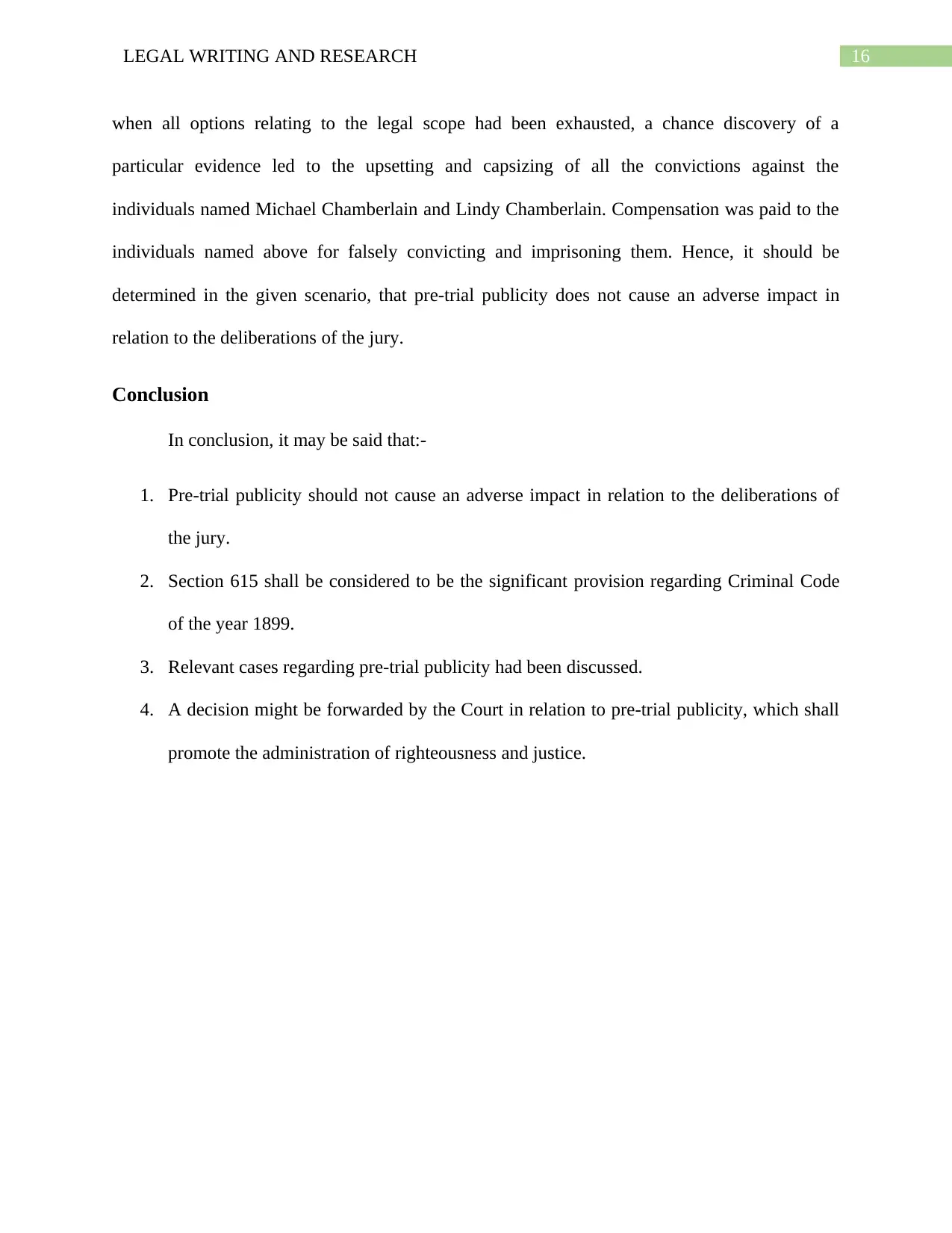
16LEGAL WRITING AND RESEARCH
when all options relating to the legal scope had been exhausted, a chance discovery of a
particular evidence led to the upsetting and capsizing of all the convictions against the
individuals named Michael Chamberlain and Lindy Chamberlain. Compensation was paid to the
individuals named above for falsely convicting and imprisoning them. Hence, it should be
determined in the given scenario, that pre-trial publicity does not cause an adverse impact in
relation to the deliberations of the jury.
Conclusion
In conclusion, it may be said that:-
1. Pre-trial publicity should not cause an adverse impact in relation to the deliberations of
the jury.
2. Section 615 shall be considered to be the significant provision regarding Criminal Code
of the year 1899.
3. Relevant cases regarding pre-trial publicity had been discussed.
4. A decision might be forwarded by the Court in relation to pre-trial publicity, which shall
promote the administration of righteousness and justice.
when all options relating to the legal scope had been exhausted, a chance discovery of a
particular evidence led to the upsetting and capsizing of all the convictions against the
individuals named Michael Chamberlain and Lindy Chamberlain. Compensation was paid to the
individuals named above for falsely convicting and imprisoning them. Hence, it should be
determined in the given scenario, that pre-trial publicity does not cause an adverse impact in
relation to the deliberations of the jury.
Conclusion
In conclusion, it may be said that:-
1. Pre-trial publicity should not cause an adverse impact in relation to the deliberations of
the jury.
2. Section 615 shall be considered to be the significant provision regarding Criminal Code
of the year 1899.
3. Relevant cases regarding pre-trial publicity had been discussed.
4. A decision might be forwarded by the Court in relation to pre-trial publicity, which shall
promote the administration of righteousness and justice.
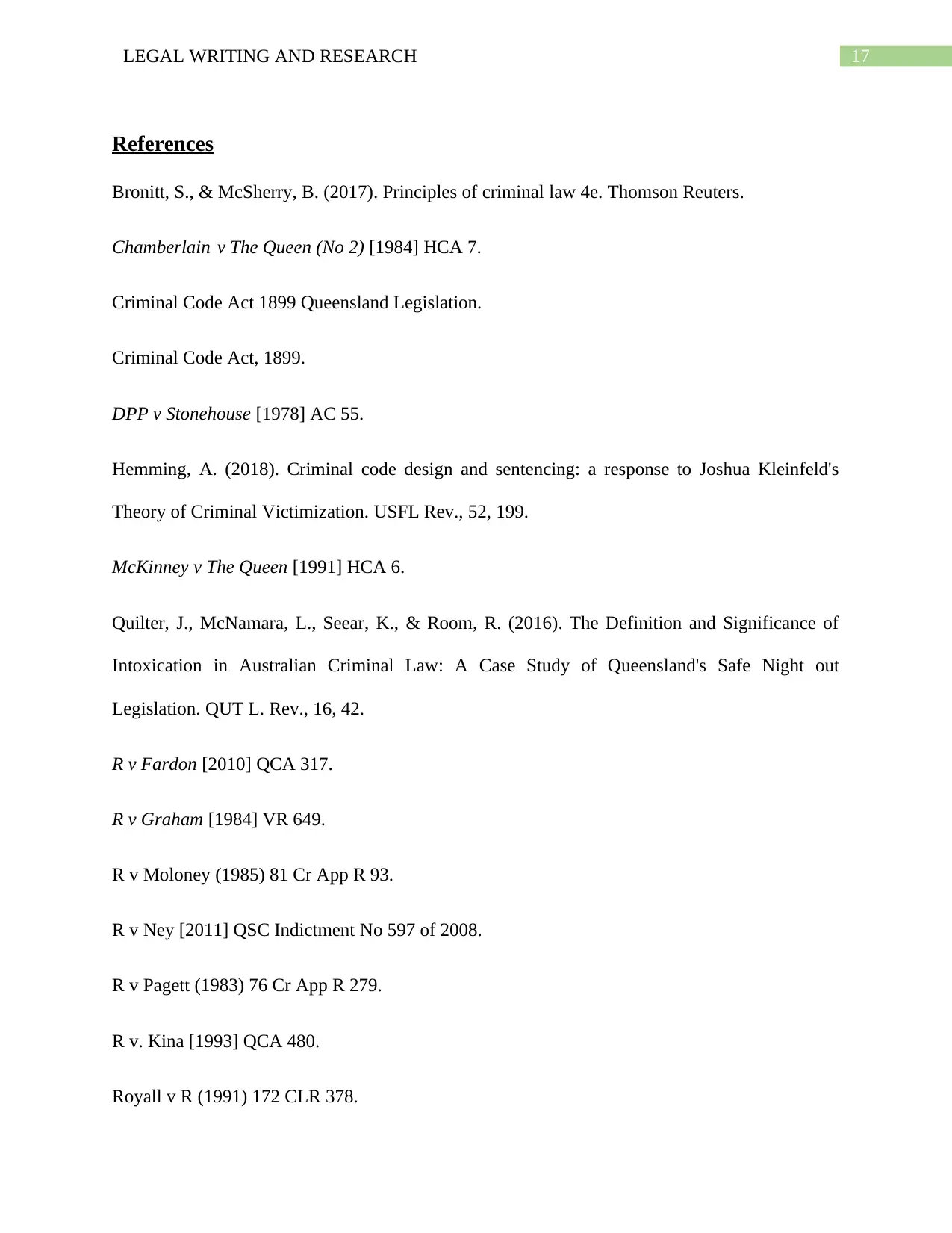
17LEGAL WRITING AND RESEARCH
References
Bronitt, S., & McSherry, B. (2017). Principles of criminal law 4e. Thomson Reuters.
Chamberlain v The Queen (No 2) [1984] HCA 7.
Criminal Code Act 1899 Queensland Legislation.
Criminal Code Act, 1899.
DPP v Stonehouse [1978] AC 55.
Hemming, A. (2018). Criminal code design and sentencing: a response to Joshua Kleinfeld's
Theory of Criminal Victimization. USFL Rev., 52, 199.
McKinney v The Queen [1991] HCA 6.
Quilter, J., McNamara, L., Seear, K., & Room, R. (2016). The Definition and Significance of
Intoxication in Australian Criminal Law: A Case Study of Queensland's Safe Night out
Legislation. QUT L. Rev., 16, 42.
R v Fardon [2010] QCA 317.
R v Graham [1984] VR 649.
R v Moloney (1985) 81 Cr App R 93.
R v Ney [2011] QSC Indictment No 597 of 2008.
R v Pagett (1983) 76 Cr App R 279.
R v. Kina [1993] QCA 480.
Royall v R (1991) 172 CLR 378.
References
Bronitt, S., & McSherry, B. (2017). Principles of criminal law 4e. Thomson Reuters.
Chamberlain v The Queen (No 2) [1984] HCA 7.
Criminal Code Act 1899 Queensland Legislation.
Criminal Code Act, 1899.
DPP v Stonehouse [1978] AC 55.
Hemming, A. (2018). Criminal code design and sentencing: a response to Joshua Kleinfeld's
Theory of Criminal Victimization. USFL Rev., 52, 199.
McKinney v The Queen [1991] HCA 6.
Quilter, J., McNamara, L., Seear, K., & Room, R. (2016). The Definition and Significance of
Intoxication in Australian Criminal Law: A Case Study of Queensland's Safe Night out
Legislation. QUT L. Rev., 16, 42.
R v Fardon [2010] QCA 317.
R v Graham [1984] VR 649.
R v Moloney (1985) 81 Cr App R 93.
R v Ney [2011] QSC Indictment No 597 of 2008.
R v Pagett (1983) 76 Cr App R 279.
R v. Kina [1993] QCA 480.
Royall v R (1991) 172 CLR 378.
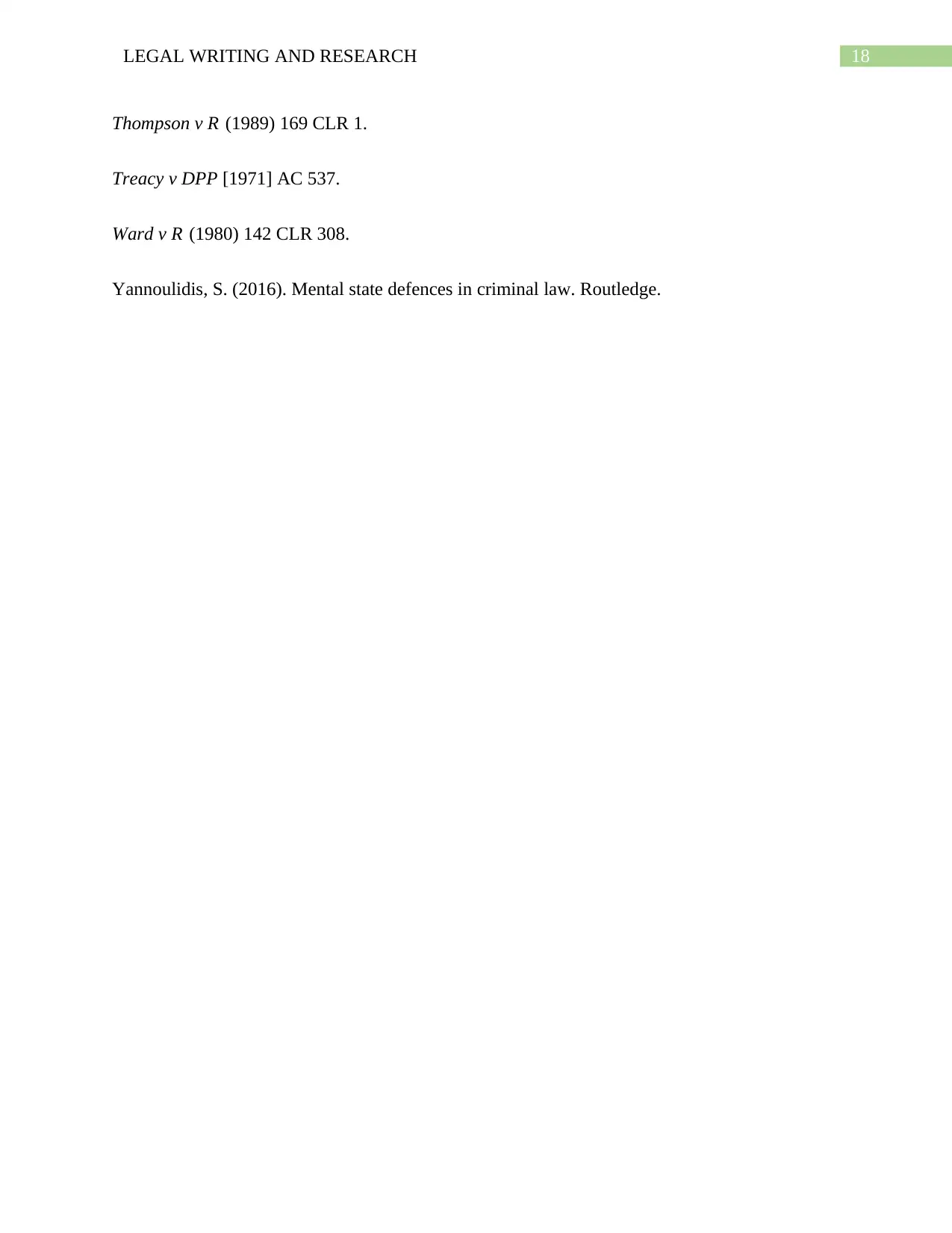
18LEGAL WRITING AND RESEARCH
Thompson v R (1989) 169 CLR 1.
Treacy v DPP [1971] AC 537.
Ward v R (1980) 142 CLR 308.
Yannoulidis, S. (2016). Mental state defences in criminal law. Routledge.
Thompson v R (1989) 169 CLR 1.
Treacy v DPP [1971] AC 537.
Ward v R (1980) 142 CLR 308.
Yannoulidis, S. (2016). Mental state defences in criminal law. Routledge.
1 out of 19
Related Documents
Your All-in-One AI-Powered Toolkit for Academic Success.
+13062052269
info@desklib.com
Available 24*7 on WhatsApp / Email
![[object Object]](/_next/static/media/star-bottom.7253800d.svg)
Unlock your academic potential
© 2024 | Zucol Services PVT LTD | All rights reserved.





